

John-Michael Battaglia interview
By Scott Stilphen
(2010)

John-Michael Battaglia was a Senior Copywriter at Atari who wrote manuals for several popular Atari VCS/2600 and 5200 games, and single-handedly gave the SwordQuest Earthworld contest its 'groove' back. He also has some interesting stories about his post-Atari career.
Q: What inspired you to pursue a career in video games?
John-Michael Battaglia: I’ve always loved to play games, ever since I was a little kid playing checkers, chess, board games, and sports games in the narrow hallway where a Player Piano was stored, next to the stairs leading to my parents' second-floor flat in my grandparents’ house. But, strictly speaking, I am not a game designer, nor would I ever claim to be, in the strictest definition of the vocation being someone who writes programming code that results in a computer software game. I never intentionally pursued a career in game design, nor did I take as my main inspiration work done by programmers or game designers. However, I did brush up against the video game industry through my close contact with game designers at Atari, and afterwards, as my overall career as a writer and filmmaker evolved.
Q: What’s your educational background?
John-Michael Battaglia: I consider my educational process to consist of formal studies through coursework in schools and colleges, as well as the on-the-job training and the self-training I give myself to learn the skills I need to perform the work I do.
My father and my grandfather worked at a Ford Motor Company assembly plant outside Buffalo, NY for their entire lives, so I was a kid from a working class family who had to find my own way to get a higher education. Having won a New York State Regents Scholarship in a statewide, competitive exam, as well as winning an Alumni War Memorial Scholarship to Colgate University in Hamilton, NY, I was fortunate enough to attend one of the finest liberal arts colleges in America. After my first semester at Colgate, I apparently displayed such an aptitude and creativity for science that my instructors tried to recruit me into a specially designed curriculum that was intended to be a talent feeder for the NASA space exploration program.
But, at age 17, I was unwilling to make a commitment to what I viewed then as a narrow career choice. I intentionally went to Colgate to broaden my horizons and to get a much wider perspective on life. I wanted to study the greatest ideas of men's minds expressed in the most exquisite style. Consequently, at Colgate, I majored in English Literature, with an equally strong minor in History. The Core Curriculum at Colgate ensured that I would also get my smattering of science, philosophy, religion, sociology, psychology, political science, economics, music, drama, and art.
I guess my instinctual desire to become a writer announced itself early, because, instead of heading down the path to become an astrophysicist, for my freshman year independent study project, I proposed to my advisor that I write short stories for the four-week "Jan Plan" interval between semesters. He said, "To hell with short stories. Go and write a novel! Come back in a month with 150 pages of fiction." That was quite an intense experience—and I wasn't even eighteen years old yet. But I got it done, and I managed to go on to graduate from Colgate with honors in English.
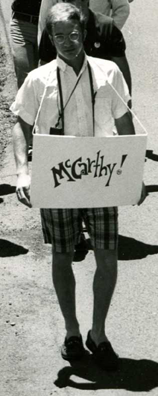
Q: What was the world like when you got out of college?
John-Michael Battaglia: It was 1968 when I graduated from Colgate University—a traumatic year in American history. The nation was polarized over the war in Vietnam. I was morally opposed to America's involvement in Vietnam. I felt that we were wrong to be there on so many levels and for so many reasons that there was no way I could support our presence there. Even though I could have easily walked over the Peace Bridge from Buffalo to Canada, I wanted to serve my country in an honorable way. So, I decided to become a Peace Corps Volunteer.
During my first two years, I was assigned to the National TB Control Program in Malaysia as an administrative coordinator. In my spare time, I taught myself the techniques of still photography and film production. I extended my tour of duty for an additional two years after getting myself transferred to the National Film Department of Malaysia, where I began my first professional work as a scriptwriter, producer, director, and editor. When I got back to the States, I worked for about six months as an advertising copywriter before entering graduate school at Syracuse University to study film and television production. Since I wanted to pursue a career as a scriptwriter and producer-director of feature films and documentaries, I felt it would be advantageous to get a more formal education in the history of cinema and the techniques of film production.
Q: How did the opportunity at Atari come about? Were they the first game company you worked for?
John-Michael Battaglia: The opportunity to work at Atari came about in a serendipitous manner.
After I had completed my graduate work at Syracuse University in 1976, I worked for a year as a freelance copywriter and publicist in my hometown of Buffalo, NY to get the money together to move to California and embark on my career as a filmmaker. With a nest egg of $2,000 and an old van that needed a quart of oil every hundred miles, I made my transcontinental journey, sleeping on a mattress in the van. Instead of going straight to Hollywood, though, I headed to San Francisco hoping to hook up with independent-minded filmmakers like Francis Ford Coppola and his buddy, George Lucas, the University of Southern California film student who Coppola selected as his production assistant, because he was the only other guy to have a beard at the time.
Within a month after I arrived in San Francisco and began making furious calls all over town looking for work, I managed to get a job at KGO-TV as an on-air producer editing and promoting a special re-broadcast of QB VII, an Emmy award-winning, six-and-a-half-hour television mini-series. From there, I smoothly moved over to KTVU-TV in Oakland as their on-air producer, promoting mostly movies and, of course, news specials.
While I greatly enjoyed the opportunity to extract exciting, enticing scenes from movies, re-edit them, write narrative copy, and be in charge of a TV station's production resources for a day-and-a-half every week to produce 30-second teasers that would entice viewers to "watch Casablanca Saturday at 5 on Channel 2," what I really wanted to do was get on with developing my ideas, writing my own screenplays, and making my own movies.
So, I did what any idealistic, artistically-oriented dreamer does: I rented a cottage at Stinson Beach, a tiny Marin County coastal community within an hour's drive north of the Golden Gate Bridge, and I got down to researching and writing a screenplay, my second. I would walk the long beach for reflection, jot down my ideas on index cards, and work on a screenplay about the life and work of Dr. Wilhelm Reich, a visionary scientist whose books were burned by the United States government in the mid-fifties.
Q: Sounds like a tough sell. What was your first screenplay about?
John-Michael Battaglia: It was called “No Man's Land”, and it was the story of a Montana rancher who refuses to sell his land to the coal company that wants to strip mine the land for it. It was about ecology, pollution, solar energy, conservation. In other words, it was controversial and ahead of its time. That one was also a tough sell.
Q: So, you were living in a very small community on the Pacific Coast and walking the beach for inspiration?
John-Michael Battaglia: Right. And the only opportunity to earn income I had during that time I was by cleaning the houses for the residents who rented them out to weekend visitors. I lived cheaply, but it wasn't enough to keep me going. So, I registered with temp agencies in the Bay Area to find work. One day, an agency called me to be an extra in a movie called "The Right Stuff," and the filmmakers needed people to fill a big hall in the scene when the astronauts are introduced to the press.
Anybody who knows anything about filmmaking knows that most of the time you sit around and wait for the camera to roll. So, while you wait, you make friends with whomever you're with. My seat-mate was Dorothy Duder, an Atari employee whose first and enduring love is the film business. She was playing hooky in order to be in the movie. When Dorothy learned that I was a copywriter and a scriptwriter, she began to recruit me to go to work at Atari. In those days, Atari provided a $500 finder's fee bonus to Atari employees who recruited professional level talent. So, Dorothy was suitably motivated to invite me to interview for a job there.
At first, I was not the least bit interested. At that point in my life, I knew nothing about Atari, and I couldn't care a fig about computers. I was only interested in being the best writer I could be and to write scripts for movies. I tried to push her away by saying that I didn't want to work for any "Japanese company!" She just laughed and informed me that Atari was not a Japanese company: it was actually a subsidiary of Warner Brothers, a major film production studio. "Oh!" I said. "Well, I'm just a little Warner Brothers myself. Maybe there could be something there for me after all."
Over the next few weeks, Dorothy sent me information on all the relevant job opportunities. I eventually got hired as a Senior Copywriter in the Consumer Graphics Department, where I was assigned to write instruction manuals and packaging copy for Atari 2600 and Atari 5200 video games.
Q: When did you start/leave Atari?
John-Michael Battaglia: My tenure at Atari lasted exactly one year, from June 1, 1982 through May 30, 1983. It was brief and meteoric—sort of like Atari itself.
Q: What was the easiest/hardest part of writing manuals? Did it require hours of game-playing, or did the programmer provide you with a brief synopsis of how the game played?
John-Michael Battaglia: You cannot write intelligently—or in depth—about anything, unless you know quite a bit about your subject. Writing the copy for a game manual always required an investment of many hours of game play. The only way to show other people how to get the most out of a game is to play it over and over again until you become familiar with every feature, every facet, and every technique worth knowing.
Arghh! All that game playing! What agonizing, back-breaking work. Nah, just kidding! When I would take a break, I used to call up my friends and say: "Hey, you'll never believe what I have to do to make money these days. I play video games all day, and I write about them." Then I'd laugh and get back to work. Or play. The two blended together into such a harmonious, indistinguishable whole that, for me, work was play, and play was work.
Q: Sounds like a once-in-a-lifetime dream job.
John-Michael Battaglia: You got that right! For me, playing a game was the necessary research I had to undertake before I could even begin to write a thing about it. There is no shortcut you can take to gain this information other than to immerse yourself into the game to learn what it's all about. You have to listen and let the game talk to you. Then you have to translate the intent of the game designer in such a way that everyone from 7 to 70 can comprehend what the game is all about and is eager to play it.
There was no synopsis anyone could give me that could take the place of me doing my own research. Nor would a synopsis—especially if it came from a programmer—do justice to the game itself. For, despite their prodigious coding talents, the game programmers were the last people on earth Atari would entrust to write a game manual, although some lobbied mightily for that prerogative. As a matter of policy, though, programmers had no effective input regarding the design or content of the manuals: that was the domain of the Consumer Graphics Department, its writers, its proofreaders, its editors, its artists, its illustrators, its graphic designers, and its printers. And we were good at it.
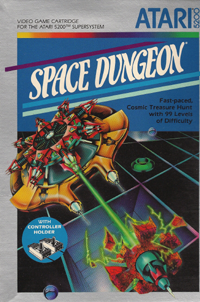 Q: Why do you think game designers weren't the right
people to write their own manuals? After all, they had to know their own programs better than anyone else.
Q: Why do you think game designers weren't the right
people to write their own manuals? After all, they had to know their own programs better than anyone else.
John-Michael Battaglia: Besides lacking the writing skills to present their game designs in a format and a style that could be accessible to a wide audience, game designers tended to see their creations in a different light than others who were not so technically or emotionally involved in the project. We writers were the interpreters, the translators, the presenters of their fine game designs. It was our job to blend the right amount of narrative story-telling with technical explanations into a finely crafted booklet which was pitched at just the right level of language comprehension, so that it would all make sense to a broad, consumer market. Talented as they were, the game designers just didn't have the right skills set to pull that off.
In terms of getting a "synopsis" to work from, I do not recall a single instance where a programmer gave me a "synopsis" of how his game was played. That was not how we worked at Atari. Essentially, when work was meted out at our staff meetings, we were given a game cartridge, and we were told to go play with it and figure out what it was all about.
Sometimes, there was no real game design for the programmer to synopsize, as, for example, in the case of Space Dungeon. When I got it, it was a nice piece of collision-detect mode with no story or substance or meaning behind it, leaving me free to concoct a scenario from whole cloth to explain what the role of the player was, what the mission was, and what the game was all about. Our editor, Andrea Kuroda, teased me about my introductory section for Space Dungeon, saying that my story-line read like a Hollywood treatment.
Imagine that! Making a movie based on a video game. Hello! Was I not working for Warner Brothers? Wasn't anybody paying attention?
Q: So, basically, as writers, you had a lot of freedom to come up with stuff for the manual on your own?
John-Michael Battaglia: Absolutely, as long as it all meshed organically with the nature and purpose of the game itself. Obviously, there had to be a recognizable correlation with the game play.
While the programmers were the acknowledged major talents in any game Atari marketed, producing a complete video game product was a collaborative, team effort that, much like a movie, demanded a synchronistic blending of a wide variety of talented, creative people to make it all happen. Writers were one of the contributing elements of that team. We could not do what programmers could do; they could not (very well) do what we could do.
Of course, we always had an open invitation to meet with and to contact the game programmer whenever we had some questions about some particular aspect of a game. More so perhaps than any other collaborator in the video game business, game manual writers like myself had the opportunity to work quite closely with programmers, albeit this was something that occurred on the level of individual personal relationships. We were not only the translators of the programmer's unique game design, but we were also their first-line bug detectors and beta testers as well.
Q: As you describe it, it sounds like everything was quite well structured.
John-Michael Battaglia: Precisely. Atari was a very well-oiled, very well-coordinated, creative factory with production schedules to meet that kept everyone busy and on their toes all the time. Just like written pieces have to go though several drafts before they're ready to be published, so, too, with video games. Writers got game cartridges as works-in-progress burned on EPROM’s. We not only wrote about what we saw on the cartridge; we also provided feedback on bugs that would be incorporated in the next round of EPROM’s. Savvy programmers used us to get feedback to help them improve their game designs in each successive EPROM burn.
Q: Another ‘layer’ of play testers! So, getting back to my original question, what were the easiest and hardest parts to write?
John-Michael Battaglia: As far as that goes, you have to take into consideration that the content of the Atari game manuals was always designed in the form of a two-part structure. The manuals opened up with an introductory, or creative, narrative section, where we had to create the character or persona of the player within the context of the mission of the game. With that role play character and game purpose established, we then had to transition to the more technically oriented aspects of the game, where we would tell people in more specific language pertinent to the game's design how to accomplish the mission.
For me, I would say that the easiest part of writing the manuals—once I had done all the research; played the game over and over so that I knew every feature and every detail; and consulted with the programmer to get my questions asked regarding the logic of different aspects of the game—was writing the technically oriented segments of the manual.
The most challenging part of writing a game manual was writing the introductory segment. Besides being the most challenging, this was also the most fun part to create. For me, it was also like putting the cherry on the dessert, because, even though I always held the concept of the role-playing character uppermost in my mind as I developed the technically oriented segment of the manual, and even though I might dash off notes to myself about how the introductory section should go, I would not allow myself to write that role-playing section until I had finished writing the technical section.
Q: Was this a personal method of yours, or was that how most of the writers approached it?
John-Michael Battaglia: I don’t know how my colleagues approached their material: I don’t even think we ever discussed the mechanics or the methodology on that level. We just did what came naturally to us, depending on how we liked to work.
For me, approaching each manual in that self-imposed, disciplined way allowed me to accomplish two goals simultaneously. First, it assured me that I would be completely honest and faithful to the game designer's intention by thoroughly covering all the technical features that he had woven into the game play. Second, with that obligation to the game designer and to the users fulfilled, I was now free to draw upon all those technical features to craft a narration that would introduce a character into a scenario of my own choosing to make the game really come alive in the minds and imaginations of the game-playing consumer.
In short, at that point, the game becomes mine, and I had free reign to tell a story that would reveal to my readers how the game—through empathy with the character I implanted into their heads—would also become theirs. In giving its talent in all areas such creative freedom, Atari was a great place to work and I absolutely loved being there.
Of course, the hardest part of writing game manuals was to seamlessly integrate the narrative introductory section with the technically oriented section so that everything connected, everything flowed, and everything worked in harmony. For me, this was also the most satisfying thing to do, for it required the most skill, and I derived a great deal of personal pleasure in being able to pull it off, time after time.
Q: What’s a good example of that integration?
John-Michael Battaglia: Take, for instance, the introductory "Hands Up! It's a Pass!" section of the RealSports Football (5200) game. After setting up some play action in non-technical terms, I wrote "Now you have to evade these blitzing linemen until the precise moment when your other receiver can most likely catch a pass, ... so your timing has to be good. Real Good." In doing that, I was creating a role-play scenario that closely integrates with the technical section called "The Art of Passing," as well as with the Helpful Hint "On Passing" contained in the Football Playbook.
I would not have been able to write the role-playing scenario without having first thoroughly played the game to master the art of passing feature, nor would I have understood the game logic of that feature well enough to write about it in depth without a thoroughly probing conversation with game designer Jim Huether.
So, for me, writing a game manual was a personal artistic challenge borne out of a collaborative effort that went way beyond the level of getting a bare bones "synopsis" of game play to translate.
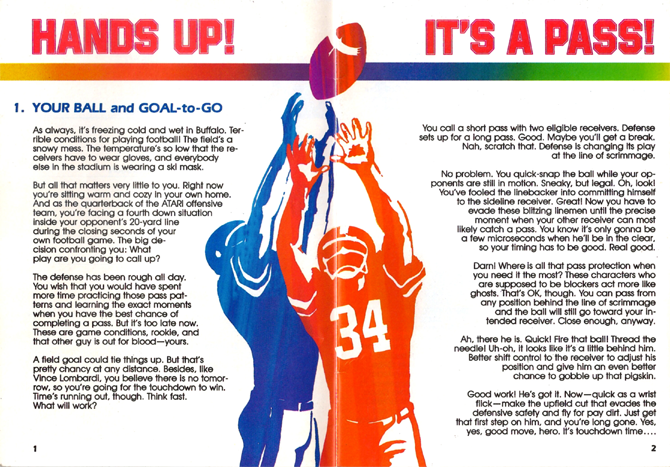
Introduction story for Atari 5200 Football.
Q: Did your background and interest in filmmaking and scriptwriting have any impact on how you approached your work as a copywriter at Atari?
John-Michael Battaglia: I suppose it did, although I did not consciously think about it at the time. In one sense, my approach to writing game manuals blended an engineering approach with a cinematic approach. I had observed that engineers tended to approach problem-solving situations by breaking things down into their elemental, constituent parts. First, they concentrate on solving the individual pieces of the puzzle to make sure that all the pieces work well in and of themselves. Then they integrate all the separate, well-functioning pieces into a whole. Finally, they work on fixing all the bugs or problems that arose when they attempted to get the individual elements to play nicely together.
My approach to writing the Atari game manuals was quite similar: it was a form of "reverse engineering" from a writer's perspective. I would begin by playing the game to get an overall feel, while concentrating on deconstructing the game's elements by focusing on—and mastering—the individual component features that would comprise the technical section of the manual. Part of the trick was to concentrate on the details while never losing sight of the whole picture.
Q: Did you ever find yourself getting lost within the game?
John-Michael Battaglia: Theoretically, that can happen, if the game is particularly complex or especially dense. But these Atari games were first generation video games. There wasn't that much memory the game designers had to play around with, so the risk of getting lost inside one of those games wasn't really that great. One of the special talents of the Atari game designers was how well they could perform within the constraints of the very small sandbox they were given to play in.
Besides, no matter how complex the game might be, as the manual writer you can't submerge yourself to such a depth that you trap yourself into playing the game forever. Atari wasn't paying me to become a full-time video game addict. They were paying me to explore the core of a video game, yes, but they also expected me to have the discipline to come back to reality and write about my trip for consumers. The consumers were the people Atari wanted to turn into video game addicts!
Q: You could go so far, but no more...
John-Michael Battaglia: Right. At some point you have to pick your head back up out of the sand and approach the material from a wider perspective. That's where the cinematic approach comes to the forefront.
Every medium has its own language and forms of expression, its own grammar and syntax. In the movies, you write with a camera. Among the many other elements of the audio-visual language, the size of your shots—how much material you frame within the shot as well as from what perspective—has a lot to do with how you reveal the elements of a story and how you pace it. In this paradigm, the individual technical features of a video game would constitute the close shots, the close-ups, and the extreme close-ups of the game.
But you can't just throw people into a bunch of close-ups and expect them to be oriented. It's not a good educational device. The mind doesn't work that way: people get lost. People need perspective. They need context. They need a hook to put their hat on.
To achieve that goal, you have to introduce people to the game slowly, by providing them with the wide shots to establish the overall context in which each feature of the game will play its part. After you provide the introductory overview to establish perspective and context, then you can move the camera in closer and closer to reveal the details.
For me, the creative challenge—and the fun—was how to deliver all that material seamlessly and painlessly so that people enjoyed taking it all in. You want to create a favorable impression enticing them to want to play the game.
Q: Were there any other challenges, or responsibilities, of a game manual copywriter at Atari?
John-Michael Battaglia: Oh, my, definitely, yes.
Beyond writing the game manuals, the greatest challenge facing Atari copywriters was to write the advertising copy for the boxes in which the games were packaged and sold in the marketplace.
After mastering the technical game features and writing the instructional manual, the copywriter had the final creative challenge of selecting the promotional screen shots and distilling all the game play features and the character role-playing mission statements into terse, scintillating body copy that would compel a customer to pick that box up in a retail store and get so excited about the game that they had to buy it.
The manuals were important to the consumer who bought the product, but they were useless if no one bought your game. You also had the write the packaging copy that would make someone buy the game in the first place.
Q: According to your website, you wrote the manuals for 4 titles:
Phoenix (VCS/2600)
SwordQuest WaterWorld (VCS/2600)
RealSports Football (VCS/5200)
Space Dungeon (5200)
Q: Were these the only titles you were involved with?
John-Michael Battaglia: You're referring, of course, to the list of titles I included in my online portfolio website. Actually, that list is just a sampler; it's not quite complete. A quick peek at my FileMaker Pro database of portfolio materials, supplemented by a trip to my attic to peek at some old files and folders, reminds me that I also wrote the manuals for the 2600 version of RealSports Football, as well as the 2600 Adventure manual for the International market.
In fact, as I glance over my notes and documentation for the Adventure game manual, I see the original memo, dated 6 December 1982, from Dennis Matthews, who was the manager of the copywriters in the Consumer Graphics Department at Atari, asking me for my help to "edit and fit ADVENTURE into the international format so that Junco can send it out for translating."
Q: What was wrong with the original Adventure manual, and what did you have to do to fix it?
John-Michael Battaglia: I distinctly remember not liking the structure and style of the original manual. Game play information was not only misleading, but it also seemed to be haphazardly strewn about, like a collection of technical data listed on a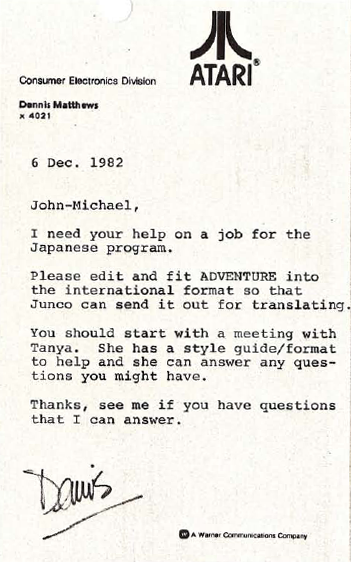 spec sheet, written perhaps more by a programmer or a strictly technical writer, but not by a narrative-oriented copywriter who could bridge the gap between the two worlds.
spec sheet, written perhaps more by a programmer or a strictly technical writer, but not by a narrative-oriented copywriter who could bridge the gap between the two worlds.
In comparison to the style we had evolved with the newer manuals, I felt that the language in the original Adventure game was relatively cold and forbidding. The copy just didn't flow well: it was choppy, and it put too much of a burden on the reader to figure out what was going on. In short, it just did not come up to our current standard. So, I took it upon myself to change things around.
Upon reflection, I guess that this small manual is another example of what I mean by using a two-part structure that blends a combination of cinematic style copywriting with technical writing. For instance, the original Adventure manual that I had to work with began its "How to Play" introductory section like this: "An evil magician has stolen the Enchanted Chalice and has hidden it somewhere in the Kingdom. The object of the game is to rescue the Enchanted Chalice and place it inside the Golden Castle where it belongs." That seems simple enough, right? A s they say, it's good enough for government work.
However, one of the conceptual problems I saw was that there was no "evil magician" to contend with. He never appeared in the game. His presence was never really felt. Another problem was in the use of the word "rescue." Linguistically speaking, we may rescue people, or perhaps projects, but we don't necessarily rescue objects. I may have been splitting a hair, but it seemed like an important hair in the whole context of the manual. So, to me, it seemed false and misleading to base the premise of the game on such misleading statements when there was a much simpler, cleaner, and more honest way to present the central idea of the game and get players into their role and on the way to accomplishing their mission.
With that in mind, I simplified the opening line to read: "Somewhere in this magic kingdom, there is an enchanted chalice which you must find and return to the golden castle where it belongs." There it is! There's the cinematic wide shot to establish the game from the biggest perspective. You're in space, floating over a magic kingdom, and you're moving in closer to the landscape, where the details begin to emerge with each textual brush stroke. I immediately moved my camera in closer with: "Three different-colored, hungry dragons promise to make your quest a real adventure, since they will gobble you up as soon as they smell you coming." And, as I get closer to the ground, I reveal more and more details about the landscape, its buildings, and its objects—at first, in a generic, non-technical fashion— and then, finally, transitioning to the more technical aspects of the game play. That was how I worked.
Q: How was your work received at Atari?
John-Michael Battaglia: My manager liked my work, and he said so. That was always a plus. On 13 January 1983, he wrote on his print-out of the newly-revised Adventure manual I had crafted: "Very nice job—excellent." It was such a small thing, and it cost him nothing. Yet, it went such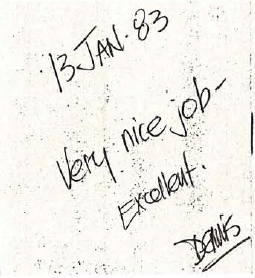 a long way to making me feel good about myself and my work. I always appreciated getting positive strokes like that. Beyond getting paid, everybody—creative types especially—needs to be positively stroked and supported in order to work at, or even exceed, their highest capabilities. You'd be surprised how many people in managerial positions do not grasp that fundamental principle, or are so emotionally cheap and constipated, that they do not know how to praise their employees
in order to get the best work out of them.
a long way to making me feel good about myself and my work. I always appreciated getting positive strokes like that. Beyond getting paid, everybody—creative types especially—needs to be positively stroked and supported in order to work at, or even exceed, their highest capabilities. You'd be surprised how many people in managerial positions do not grasp that fundamental principle, or are so emotionally cheap and constipated, that they do not know how to praise their employees
in order to get the best work out of them.
Coming primarily from a film writer/director's background and an orientation towards the performing arts, my managerial style is to treat creative people positively and with the greatest respect and admiration. You're hardly going to get a good performance out of actors if you treat them badly and cause them to shut down emotionally. It affects their creativity and makes it impossible for them to deliver. I knew all that.
But most corporate folks usually don't. They live in hierarchical worlds built upon degrees of power, authority, and obedience to rules, not on equality, individuality, and thinking of creative ways to go beyond the rules. Fortunately, Dennis grokked all that. As a writer himself, he empathized with his writers. He understood things from our perspective. So, in my book, Dennis was a great manager. He not only knew how and when to praise and stroke his writers, but he also protected us against the shifting uncertainties, the perpetually shifting schedules, and the potentially disruptive corporate politics generated by the needs and desires of upper management and other departments.
It wasn't until later, when I came into contact with a new breed of self-centered, incompetent, brow-beating, power-hungry managerial types that I was able to appreciate what special talents a good manager must have, as well as how rare those talents are.
Q: It's interesting to learn about the details of your re-writing that Adventure manual. There's obviously a lot more to writing than meets the untrained eye. Was there anything special that you remember about any of the other titles that you were involved with?
John-Michael Battaglia: Sure. I suppose the two other manuals that remain strongest in my memory are the ones I wrote for 5200 Space Dungeon and RealSports Football, which we referred to internally as “Pam” football.
As I mentioned briefly, the Space Dungeon project came to me with no pre-conceived story-line. The programmers—Allen Merrell and Eric Knopp—had done a fine job of porting over an arcade game for the home consumer market, but they really had no information other than the basic game play parameters as to what the game was "really" about.
Granted, once you get involved in an action-adventure game like Space Dungeon, you may no longer need to remember what the conceptual premise of your character is and what your mission is, because you'll be so absorbed in manipulating your space ship in the ante-chambers of deep space picking up treasures and avoiding enemies, that you can't be bothered. But that's the whole point of the exercise: to brief you on your role and your mission, and to send you on your merry way, so you don't have to think about it anymore and you don't get lost along the way. In any event, the programmers had been busily engaged in adapting arcade game play code into a home-based video game format, so it was now left to me to provide a conceptual frame for their game, as well as to translate their code into instructions that would be useful to consumers.
As I refer to the notes in my folder for the Space Dungeon project, I find the original print-outs of the introductory section for the game, showing its evolution on those wide, 11x15-inch, dual-perforated sheets that were spit out by the Wang Labs printers we used in our department. When I began work at Atari, we were using Tandem Computers, but we switched to Wang computers during the year I was there.
During my background research, I had discovered a photocopy of a newspaper story by Charles Petit in the January 26, 1983 San Francisco Chronicle entitled "Dramatic New Probe of the Universe Begins." The article described the launching from Vandenburg Air Force Base of an infrared telescope into outer space to "probe dark and cold secrets of the universe," especially the "uncharted distant planets of the sun."
As I now look over the pages of notes and drafts and working titles that I went through in order to finally arrive at the concise introductory section that became "Legacy of a Distant Planet," I can see how I took my inspiration from that real-world astrophysical mission of Caltech's infrared telescope. I can also see how I blended that news story together with the essential game play parameters of the programmed code, along with my own personal interests and perspectives at the time, to come up with a story-line that works for everyone. By that, I mean a story-line which emerges organically from the intrinsic nature of the source material itself, not some phony decoration which is tacked on, easily spotted, and thus rejected.
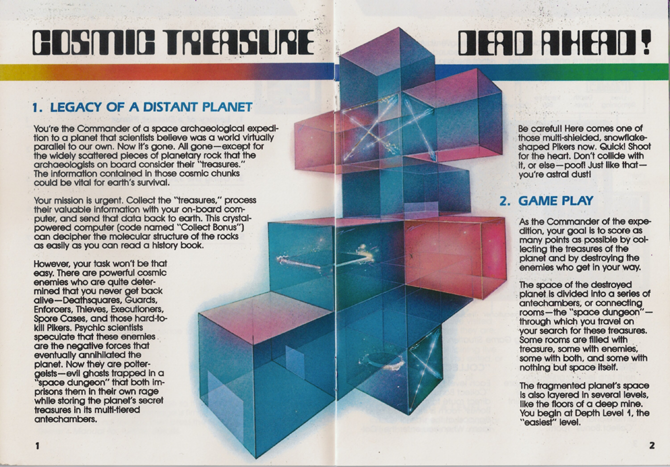
Introduction story for Atari 5200 Space Dungeon.
Q: What “personal interests” are you referring to?
John-Michael Battaglia: I placed a conceptual frame upon the game that put the player in the role of the Commander of a space ship on an archaeological mission into deep space to examine the debris of a planet that astrophysicists believed was a world virtually parallel to our own. You have a specially designed on-board computer that can decipher the molecular structure of all this space rock, which you consider "treasure" because it all has point value. And, to perform your mission you have to avoid getting annihilated by powerful cosmic enemies, which are the poltergeists, or negative forces, trapped in this "space dungeon" of their own design, due to their inability, when alive, to handle their anger and their rage. Your mission is vital for earth's survival, because the information contained in those space rocks could teach us how to avoid suffering a similar fate.
Essentially, without any heavy-handed preaching or moralizing, I slipped in a touch of Wilhelm Reich (Life Energy, the health value of allowing emotional energy to flow freely in the body); a smattering of metaphysics (spiritual, psychic energy remains after the death of the body); a dash of psychotherapy (advice on how to handle negative emotions); and a political message that if we, as a species, did not learn how to handle our own emotions and how to take personal responsibility for the flow of Life Energy through our bodies, that we were headed on a course of self-destruction like the fate that befell the inhabitants of the distant planet that blew itself up into a "space dungeon."
Of course, I had no illusions that anyone would possibly grasp all this—at least not consciously, or directly. Or that anyone would even care. In the shoot-em-up game genre, most people just want to get on with things and blast the bad guys.
Still, as long as I could pull all this off seamlessly, while also remaining true to the game—that was always my first priority—I felt it was important to plant such seeds, even subliminally. Those seeds will grow in a fertile mind, and, when the time is ripe, they will resonate when they hear an echo of themselves in another similar idea, though they may not consciously recall how, or when, the original germinal idea was planted.
Anyway, there's one more anecdotal example how a copywriter like myself could provide a conceptual framework for Atari games that would make the product we sent to the market as complete, as attractive, as informative, and as entertaining as possible.
I think you'll have to conclude that writing and designing a game manual was a far cry from just getting a synopsis from a programmer. In the Consumer Graphics Department, we all worked hard to add value to the original game design, in whatever way we could. Those manuals are little gems, just like the games they accompanied.
Q: And what about "Pam" Football? You mentioned that as a memorable project.
John-Michael Battaglia: Ah, yes, I still have fond memories of working on that project. Jim Huether programmed what I believe is the best sports title for the Atari 5200 product line and one of the best overall games Atari ever distributed to the market. I worked closely with Jim when I wrote the Football manual for his Atari 5200 game. He mostly worked at home, and he's the only game designer who ever invited me out to his house to consult on the game and its manual.
Jim's game was so feature-rich and exquisitely detailed that I had to write a manual that was much bigger than all the other manuals we were producing, just so that I could do justice to the game and completely cover all its features. To give you a measuring stick, I could cover Atari 2600 Football in 7 pages, Phoenix in 6 pages, and Space Dungeon in 8. But it took me 18 pages to adequately present Atari 5200 Football. Since producing so many "extra" pages for a 4-color manual printed on the kind of high-quality glossy paper stock we used can add considerably to the cost of marketing a product—not only in regards to the printing costs, but also in respect to the additional time and labor involved by our Consumer Graphics talent for the writing, the editing, the additional illustrations, artwork, and graphic design—I often had to convince my manager at staff meetings that Pam Football was indeed a product that was worth the extra time, effort, and cost, and that there was no short-cut but to do the job right.
In fact, we not only had to produce a thicker manual with more pages, but we also had to produce—and print—two separate, 8-panel, 4-color Playbooks (one for the Home Team; one for the Visitors) on endurable, hard-card, coated stock that illustrated, in text and diagrams, every offensive and defensive play that each team could run, along with my helpful hints "On Passing" and the "Field Goal Completion Table."
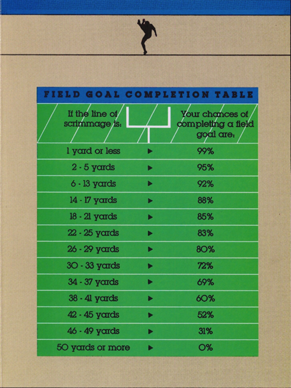
Q: In my interview with Jim, he indicated that he had implemented all facets of the game.
John-Michael Battaglia: He did. No question about it. The game's design was Jim's and Jim's alone. But it was in respect to the field goal completion table that Jim kindly allowed me to have some input that improved his initial spec for that one feature.
During one of our meetings, I suggested that Jim program some actual NFL statistics into the field goal kicking segment of the game, so that players could make a rational choice as to whether to attempt a field goal, or not, based on the distance from their line of scrimmage to the goal line. Up until that point, Jim had programmed the field goal kick routine to be entirely random. I didn't like that idea at all, and I didn't think consumers would either, so I made a deal with Jim that if I managed to get the official stats from the NFL regarding field goal completions, he would program them into the game, and I would develop a chart for the instruction manual. That's exactly what we did.
Q: How was it that Jim's name got printed in the manual, since that wasn’t exactly Atari’s procedure at that time?
John-Michael Battaglia: Well, I guess you can blame me for breaking down that barrier. I included Jim's name in the instructional manual to give him a credit as the game's author and designer, just like our parent company, Warner Brothers, gave to its film stars. But doing that sure did get me in trouble with my manager.
Atari had a sign-off and error-checking system that was very tight, very thorough. Even after all the eyes looked over my copy and it weaved its way up the chain through the often interminable process of being signed-off by everyone who ever so much as had a fingerprint touch on any phase of the manual's development, Jim's name miraculously got printed on the inside page of the manual.
Even though Dennis, my manager, must have seen Jim's name in the manuscript and he must have signed off on the project at some point in our rigid approval process, he still screamed bloody murder at me for managing to "slip" Jim's name into the manual, saying did that mean Atari should now list credits for everyone that participated in the production of the game, from the game designer to the illustrators and graphic artists and copywriters and the proofreaders and editors and printers of our entire Consumer Graphics Department. When I answered unequivocally, "Yes, of course," Dennis got beet red angry and threw me out of his office.
In those days, Atari was trying desperately to keep its talent under wraps, probably out of fear of thieving head hunters, so they didn't want the names of their star programmers known. Nor did they fully realize that software development was a team effort, like a movie, in which artistic contributions are required from a wide variety of creative people. Nowadays, it is standard procedure to click on the "Get Info" or “About” button of a software application to get the full list of people who developed the game or program, but it was taboo when Atari was king of the heap.
Q: Did crediting Jim in the manual play any part in your short time at Atari?
John-Michael Battaglia: At the time, I initially felt that it was because of this "bad" behavior of mine—my attempt to give credit where credit is due—that Dennis selected me to be the first one to get the ax in our department when the massive reduction in force which took place at Atari began in mid-1983.
But upon reflection, I know that Dennis was a much fairer and a more reasonable person than that. He would have taken all factors into consideration and do what was best for the department. Atari was dying - we all saw it; everybody had to go. It was just a matter of timing when your turn was coming.
Dennis was our manager, so he knew all of our schedules. I was up-to-date with all of my work, having gotten all of my assignments to milestones where they could be handed off to the next phase of printing and production with no further input from me. So, it made sense that I could be let go and the others kept—for just a little while longer, at least—until their work was completed and it was their turn to leave Atari-land.
Dennis and I had a few beers about all this on my last day, so it was cool. You can't get paid to play video games forever, I guess, much to my dismay.
Besides, it didn't really matter. Within a week, I was working directly for Atari-founder Nolan Bushnell, as his publicist, over at Catalyst Technologies, his high-tech incubator and venture capital firm. During the year I worked at Atari, I came into contact with Paul Solomon, who was nominally working as Nolan's publicist while he was writing a book on Nolan's life and the founding of Atari. When I called Paul to say that I was unemployed and available, he hired me right away to take over his publicist duties, while he concentrated more on writing his book on Nolan.
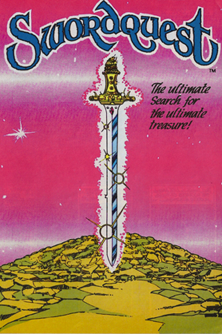 Q: You also wrote the hint sheet for the
SwordQuest EarthWorld contest. Did you write the manuals or hint sheets for any other SwordQuest games?
Q: You also wrote the hint sheet for the
SwordQuest EarthWorld contest. Did you write the manuals or hint sheets for any other SwordQuest games?
John-Michael Battaglia: To say that I only wrote a "hint sheet" for the SwordQuest EarthWorld contest is to trivialize what I did for that competition. I did considerably more than that. When you really look at it, I took the fundamental coding of that ill-conceived, punitive program, and, by blending clever word clues, I transformed it into an enjoyable, playable game. And, I did it all within two days!
Actually, rescuing that awful game and making the EarthWorld playoff contest a success for all involved is one of the things I am most proud of in my entire tenure at Atari. It also demonstrated—to those few who had the eyes to see—that you didn't have to be a code-writing programmer to be a game designer.
Q: Can you elaborate on that a bit?
John-Michael Battaglia: Well, Scott, I understand that you have expert knowledge of the entire SwordQuest series, so what I tell you, you may already know. Perhaps even more than me. I only know what was given to me, what I worked on, and what I produced. I can offer my feelings and opinions on that process, and you can incorporate it into your expertise, as you see fit.
As you know, the $150,000 SwordQuest Challenge was conceived to be a set of four, inter-related games to be released—not all at once, but according to a staggered schedule—over a period of a year or two. The titles of the four games were to be based on four of the five classical elements of air, earth, fire, and water (the fifth classical element, the ether, is one of the subjects I was studying in my research for a film on the life and work of Dr. Wilhelm Reich regarding his discovery of orgone energy, but that is a much deeper discussion that goes far beyond the scope of this interview on video games, so we'll have to leave that for another day).
Since Warner Brothers was the parent company not only of Atari, but also of DC Comics and the Franklin Mint, some ing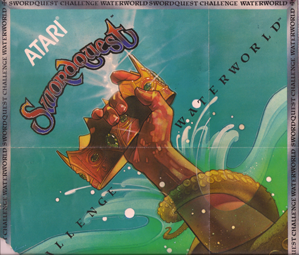 enious marketing
wizard came up with a plan that integrated the products of all three subsidiaries into a contest called the SwordQuest series. The essential components of this plan required consumers to buy an Atari video game, figure out some clues that related to a DC Comics book, and win an invitation to come to Atari and compete in contests for jewel-encrusted swords to be manufactured by the Franklin Mint. Winners of each of the elemental world games would win a jeweled sword valued at $25,000,
and the ultimate winner in a contest between those four semi-finalists would win a jewel-encrusted sword worth $50,000.
enious marketing
wizard came up with a plan that integrated the products of all three subsidiaries into a contest called the SwordQuest series. The essential components of this plan required consumers to buy an Atari video game, figure out some clues that related to a DC Comics book, and win an invitation to come to Atari and compete in contests for jewel-encrusted swords to be manufactured by the Franklin Mint. Winners of each of the elemental world games would win a jeweled sword valued at $25,000,
and the ultimate winner in a contest between those four semi-finalists would win a jewel-encrusted sword worth $50,000.
While I was in the middle of writing the manual and all the associated promotional materials for WaterWorld, which was the third game in the series, the time for the playoff contest for EarthWorld, which was the first game, was scheduled to occur. Since I was the writer whose head was most fully-engrossed with a SwordQuest project at the time, Dennis cleared it for Joel Oberman, the product manager for the SwordQuest series, to come directly to me for help.
Joel came to me in a near panic state of mind. He informed me that within a couple of days, nine people were flying to Atari at our expense to take part in a play-off contest based on the EarthWorld game. He emphasized to me that someone had to win that contest within 90 minutes in order to be awarded a jeweled sword at the luncheon ceremony to follow.
Of course, the inherent problem with this plan is the brute-force design of the original game—a design that made it nearly impossible for anyone to get through the game within a single lifetime. To put it another, even less charitable way, I view EarthWorld as the kind of a punishment a judge might mete out to a convicted serial killer: "I sentence you to serve six lifetimes, or to find the correct answers to EarthWorld, whichever comes first."
Undoubtedly, the six lifetimes will come first.
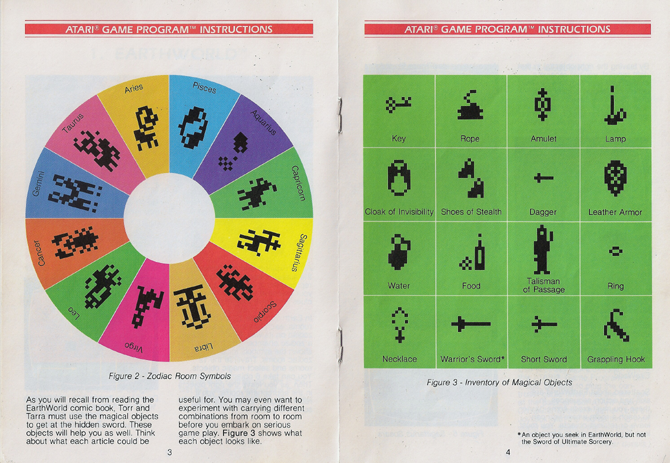
SwordQuest EarthWorld manual showing the Zodiac room layout and inventory objects.
Q: Excellent interpretation J If Dan Hitchens set out to make the ‘mother of all exercises in futility’, he succeeded.
John-Michael Battaglia: Just consider the math involved in figuring out EarthWorld. You've got 12 rooms into which you have to deposit the right combination of 16 objects in order to move on to the next level and do the same thing again, until you reach the final level. Sometimes, it only takes one object to unlock a level; sometimes, it takes two objects in the same room; sometimes it takes more than two objects in more than two rooms.
Before I got into this writing gig, I used to be pretty good at math. But I can't even begin to formulate the equation to calculate the odds of figuring out what it would take to solve this sucker!
Are we talking about 16 raised to the 12th power, or 12 raised to the 16th power, to determine what it would take to correctly place just one object in one room? How do we then come up with an equation that factors in the probability that more than one object needs to be placed in more than one room in order to move on to the next level? I'd sooner count the grains of sand on Stinson Beach.
So, on the mathematical absurdities alone, I'm sure than any serial killer given the EarthWorld sentence would have begged to be tortured on a roasted spit rather than have to endure such insanity. To this day, I have no idea how nine people managed to discover the correct set of clues that got them invited to the contest in the first place!
Joel even acknowledged the inherent unplayability of the game to me, which was probably why he was in such a panic mode.
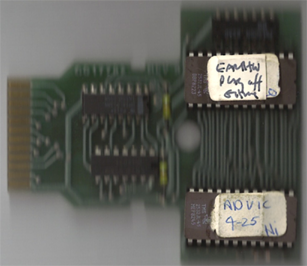
Q: I’m sure he was. I’ve yet to meet anyone who can honestly say they solved the game by playing it straight out. More than likely, either the solution leaked out, or someone derived the solution by analyzing the code, and it got passed around. Ironically, you didn't even need the game to deduce the solution to enter the contest - all you needed was the comic book! How did the contest version of the game come about?
John-Michael Battaglia: Since it was Joel's responsibility to see that the contest came off OK, he had a solution all worked out, he said, as he handed me a specially-burned EPROM cartridge. He had instructed Dan Hitchens, the programmer, to reprogram the game so that the game play would be exactly the same, but that the solutions would be different. Then, he gave me a sheet of paper on which Dan had scribbled the solutions showing which objects needed to be put into which rooms in order for players to move onto to the next level.
Joel wanted me to merely transcribe Dan's notes into a nicely formatted answer grid that we would hand out to the contestants and turn them loose.
I refused.
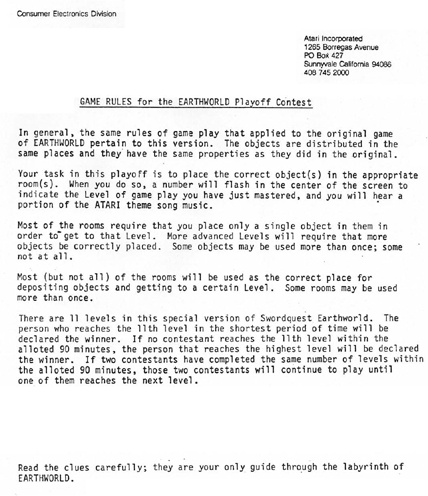 Q: Why did you refuse? Could you do that?
Q: Why did you refuse? Could you do that?
John-Michael Battaglia: I felt that I had to. It was a judgment call.
I told Joel that, if we did what he proposed, we would merely be turning the contest into a phony race. There was no fun in that! He said, “Well, of course, it has to be a race. Someone has to win in 90 minutes. So, just tell them where to put the damn objects and be done with it.”
Although he was getting upset, I still refused to do it that way, because, to my way of thinking, there just wouldn't be any fun in giving the contestants a cheat sheet with the answers already filled in, with us telling them all they had to do was race around to the different rooms to put the right objects in the right rooms. If I were a contestant who flew across the country to participate in a contest like that, I would be highly insulted and very disappointed with Atari.
Besides, I had just finished writing up the advertising copy for the poster promoting the WaterWorld Challenge aspect of the series, the flip-side of which delineated the Official Rules. So, the contest rules were quite fresh in my mind. Rule #6 specified that, "The play-off to be held at Atari's headquarters will consist of a time-measured skill competition among the field of finalists to play and solve a new, special-edition Atari adventure game, similar in nature to the original ... game, which has been prepared exclusively for purposes of the play-off. The first contestant to furnish this new game's correct answers shall be declared the winner..."
I told Joel that I considered his proposal neither a "new, special-edition Atari adventure game," nor a test of skill. I said that, in keeping with the spirit and legal language of the Official Rules, we needed to come up with some new element of game play to make the contest fun. I told him I'd think about it and see what I could come up with. He left, and the pressure was now on me.
Q: What was the solution you finally came up with?
John-Michael Battaglia: I took as my inspiration the fact that the twelve rooms of EarthWorld were named after the signs of the Zodiac. From my own reading over the years, I knew more than a little about astrology, but, as it turned out, the girl I was dating at the time was a semi-professional astrologer. She knew much more than I did. She actually gave readings.
So, that night at dinner, I asked her to brief me on the significance and the connotative meanings of each of the signs of the Zodiac. She did, gladly. Next day, back at the office, I took Dan's cheat sheet, and I sat down to write a series of arcane clues, using clever word play that integrated both the connotative meanings of the astrological signs of the Zodiac with the objects that needed to be put into the rooms of EarthWorld.
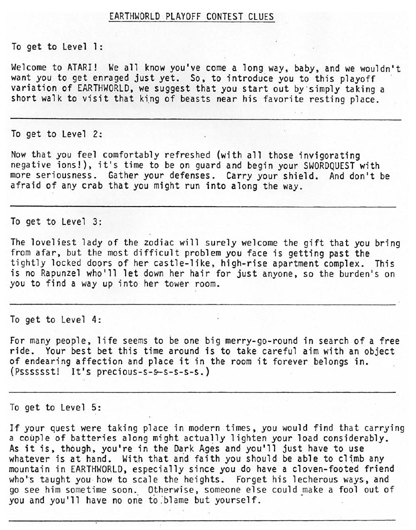 For example, to get to Level 4, instead of writing, "Put the ring in Sagittarius," as Joel had directed me to do, I wrote, "For many people, life seems to be one big
merry-go-round in search of a free ride. Your best bet this time around is to take careful aim with an object of endearing affection and place it in the room it forever belongs in. (Psssssst! It's precious-s-s-s-s-s-s.)"
For example, to get to Level 4, instead of writing, "Put the ring in Sagittarius," as Joel had directed me to do, I wrote, "For many people, life seems to be one big
merry-go-round in search of a free ride. Your best bet this time around is to take careful aim with an object of endearing affection and place it in the room it forever belongs in. (Psssssst! It's precious-s-s-s-s-s-s.)"
Since I knew that all the contestants already had an intimate knowledge of the names of the twelve rooms, as well as the names of all sixteen objects, the challenge—and the fun—was to quickly decipher the word clues I provided, and then use their joystick to maneuver through the game and take the correct actions.
In the example I just presented to you, I gave them several references to the "ring" object, including: (1) you grab a brass ring when you're on a merry-go-round to get a free ride; (2) a ring is an object of endearing affection —it symbolizes love lasting forever; and (3) a ring was the obsession of the Gollum character in Tolkien's Lord of the Rings, which I had read over a decade earlier, when I was a Peace Corps Volunteer. The reference to "take careful aim," of course, identifies Sagittarius as the correct room where you must place the ring, because the visual symbol for Sagittarius is the image of an archer.
And so it went, through all eleven levels of the contest clues, each one more complex than the previous, but every one just as playful, just as inventive, just as witty. Just as importantly, each clue was tightly and organically wedded to the fundamental game structure and game play, with which the players were familiar and comfortable, so they lost no time getting into the flow of the modified version which I presented to them.
So, you can call those contest clues "hints" if you prefer, but, from my perspective, I transformed a punitive, frustrating, brute force program into a playable game and a memorable experience enjoyed by all. If you were in the contest room to hear the giggles and see the smiles on the contestants' faces as they gleefully unraveled the esoteric witticisms of my mind, you would most certainly have agreed.
Joel did. He ended up me writing a personal memo of thanks and a commendation for making the contest a success. The Atari newsletter picked up the story and published it for the whole company to enjoy. It was one of my finest hours at Atari.
 Q: What was your opinion of the SwordQuest contest?
Q: What was your opinion of the SwordQuest contest?
John-Michael Battaglia: Pretty much everything I know about the SwordQuest contest I've summarized and reported at my portfolio website (link below), where I describe my roles in writing the manual and the promotional materials for WaterWorld, along with the contest clues for the EarthWorld play-off contest. My web site also contains the complete set of EarthWorld contest clues I wrote, as well as all the answers to the play-off game that Dan Hitchens passed along to me. Because of your great interest in that series, I just told, for the first time, the background story as to how things evolved.
As to my overall opinion on the SwordQuest series, at the time I thought the SwordQuest contest was a very clever—though somewhat hyperbolic and over-the-top—marketing ploy dreamed up by some marketing guru at Warner Brothers to exploit and promote the resources of three of its subsidiaries. I'm not really sure who gets credit for dreaming up such stuff.
However, as you can probably infer from my report on the EarthWorld contest, I thought that the original design for EarthWorld was abysmal. Since EarthWorld lacked a rational schema and a set of game play clues that could inform players how to bridge the gap between the utter randomness of dropping objects into rooms to see what would happen, it was utterly lacking in an essential component of good game design.
To me, EarthWorld was a game designed to please only masochists. On those grounds alone, it's no wonder that someone had to dream up a desperate promotional contest like the SwordQuest series with jewel-encrusted swords to induce people to play the damn game. No one in their right mind would bother wasting their time otherwise!
Executing a single, good game design is a challenging enough enterprise in and of itself. But coordinating the design and production of four thematically inter-related games—each one based on an ill-conceived game concept engine—in association with three unassociated subsidiary companies of a parent company, is not an easy thing for any company to manage. It was especially difficult for Atari, a video game software company that was really good only at producing and marketing one-shot gems—not franchises, or variations on the same theme.
Also, regardless as to whether or not the SwordQuest challenge concept was a good marketing idea, it turned out to be impossible for the series as a whole to achieve success in a business as dynamic as the video game industry was at that time, so trapped and doomed was Atari, as it approached the end of its life cycle, due, in part, to competition from other game machines, but also due, in part, to a price war, consciously or
unintentionally, inflicted upon it by Jack Tramiel, Atari's subsequent new owner, whose rut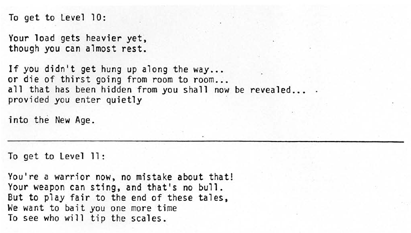 hless "Business is War" philosophy ironically destroyed the very company he soon took over and
ultimately relegated to the trash heap of computer history.
hless "Business is War" philosophy ironically destroyed the very company he soon took over and
ultimately relegated to the trash heap of computer history.
The fact that Atari as a video game company devoted to making entertainment software for the home consumer market did not survive long enough to complete the fourth and last game of the SwordQuest series—either due to external competition from other game-playing machines, or due to internal obliteration by its new master—is proof enough of the folly of the contest.
In any case, after I was laid off from Atari during the Grim Reaper's relentless scourge of the company, my interest in the SwordQuest contest waned considerably. So, I never tracked what happened afterwards, nor did I really care to investigate the topic, until recently, when I updated my portfolio web site, and when you contacted me for an interview.
Q: Not only that, the rumor is that Jack Tramiel ended up with not only the WaterWorld and AirWorld contest prizes, but the sword as well!
John-Michael Battaglia: Why am I not surprised to learn that?
Q: What were the hours in your department? Was your schedule fixed (i.e., 9 to 5) or could you basically come and go as you pleased?
John-Michael Battaglia: Unlike perhaps the programmers, whose work was primarily solitary and could be done at all hours of the day or night, as well as at home, Consumer Graphics Department staffers needed to interact with each other in our office setting on a regular basis in order to coordinate all the aspects of producing our printed publications. I would not say that we all kept bankers' hours, but, for the most part, we all worked regular day-time shifts so that we could attend regularly scheduled staff meetings, as well as be available to each other on an as-needed basis for short, spontaneous meetings, or to answer queries quickly, so that each team member's work could progress as quickly as possible.
Q: Were the titles you worked on assigned, or chosen by yourself?
John-Michael Battaglia: By and large, titles were assigned to us by our manager, Dennis Matthews, at the regular weekly staff meetings, where we would each report on the status of our works-in-progress. It's been quite a long time now, so my recollection is not perfect, but I do not recall Dennis ever really dictating assignments to us in some sort of authoritarian manner. He was quite diplomatic and tactful in meting out work.
While we did not explicitly choose assignments by ourselves, Dennis always made sure that each of us was happy with the projects he assigned to us and that we were well suited to the topics, as well as with the particular game designer we were to partner with and support.
As with any company, there are always some people who are easy to get along with and others who are a pain in the ass. It's no secret that some of the game designers had huge egos or eccentric personalities. We might groan, or complain, if we were assigned to work with someone like that, because we knew that it was only going to make our job harder and maybe a bit unpleasant. Dennis listened to our hesitations and always made sure that we were suitably matched up.
I personally never had any issues with the game designers I was assigned to work with. I liked them all as people, and I tried to make their games come alive as best I could.
Q: Were there any games or projects that you worked on that ultimately never got released or even finished?
John-Michael Battaglia: Nope. All of the games and projects I worked on were released—either during my tenure, or shortly thereafter. WaterWorld was released after I was separated from Atari, of course. I had completed writing the manual and all of the packaging copy, so, rather than give me another assignment during that company-wide downsizing time, Dennis just cut me loose.
Q: Do you recall any other titles that other programmers were working on that were never released, or finished?
John-Michael Battaglia: No, it's been way too long for me to recall what may have happened to projects with which I had no emotional attachment or intellectual association.
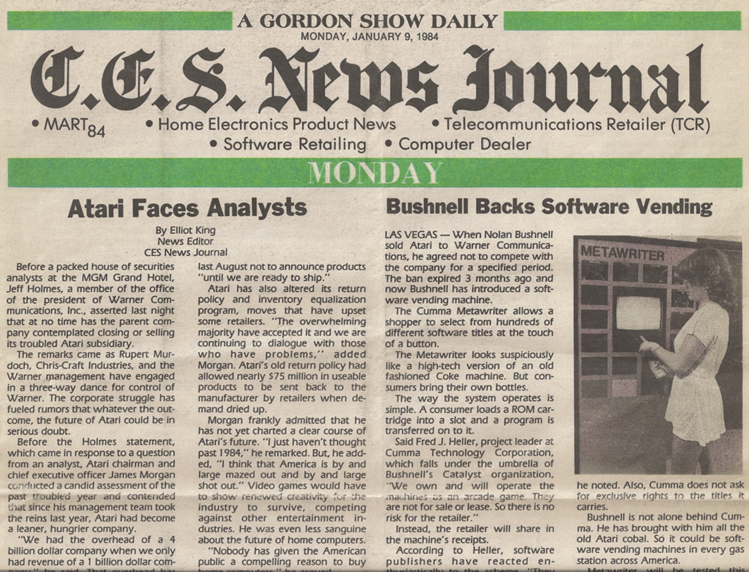
Q: Right after Atari, you went to work for Catalyst Technologies. Can you tell us about your experiences working with Nolan Bushnell, as well as working for some of his post-Atari companies such as Catalyst Technologies and Cumma Technology? We know Catalyst was an ‘incubator’ for start-up companies, and Cumma was one of the few companies working on establishing an alternative method of distributing games with their MetaWriter machine.
John-Michael Battaglia: I considered Nolan an inventive genius in the high tech sector, because he had a personality that combined several rare qualities. He had the engineering knowledge, the high tech savvy, the visionary marketing acumen, and the daring entrepreneurship everyone admired. He was also very articulate, a great motivator, and an inspirational leader. He was passionate about his work, and he had the ability to transfer his enthusiasm to everyone around him. I liked him a lot. I respected him for all of his fine qualities and accomplishments.
Yet, he was far from perfect. Unfortunately, there was a cruel and sadistic side to him which surfaced during a dinner following Cumma's participation at the January 1984 Consumer Electronics Show in Las Vegas that led to my separation from him and his Catalyst Technologies enterprise.
It's rather personal and a little painful to recall, even now. I don't know that my sad story will add all that much to the history of Atari, or its players. After all, Nolan Bushnell is included the Video Game Hall of Fame in Ottumwa, Iowa, as well he should be. I'm nobody.
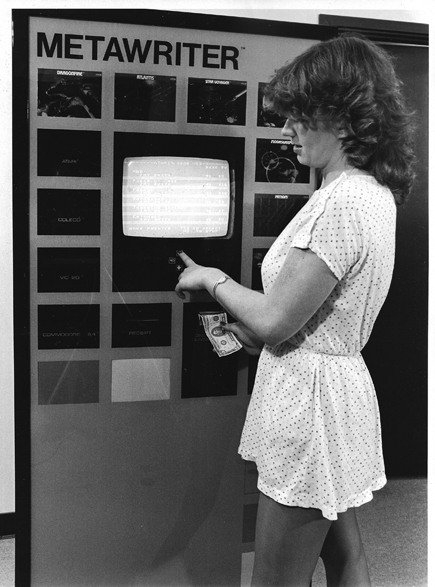
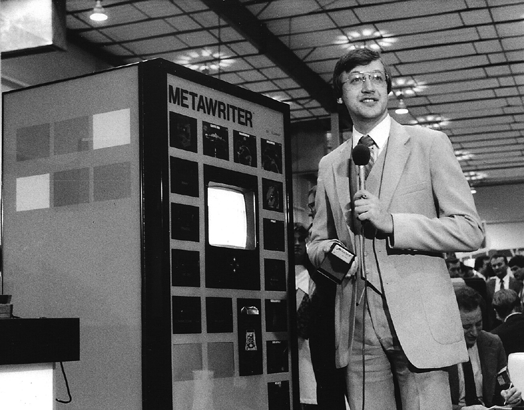
The MetaWriter kiosk shown at the January 1984 CES.
Q: If you’re up to it, I’d love to hear about it.
John-Michael Battaglia: Well, we all know that Nolan Bushnell is the technical genius who invented the computer game of Pong, an achievement that resulted with Nolan being widely recognized as the father of video game industry. The success of Pong led to the founding of Atari, and the intense market demand for video games made Atari the fastest growing company in American history. A creative engineer, Bushnell sold Atari to Warner Communications, and he used the proceeds to launch Chuck E. Cheese's Pizza Time Theaters.
With Chuck E. Cheese as the primary financial engine, Nolan founded Catalyst Technologies, a venture capital company Nolan bank-rolled as an incubator (i.e., a "catalyst") to support the simultaneous development of several (potentially very lucrative) high-tech industries he had conceived. Buoyed by success, Nolan thought big. Really big! He didn't just conceive of individual products, mind you. He visualized things in terms of entire industries. He left it for others who followed to develop the individual products that would compete for success within those industries. To me, thinking big like that was Nolan's special gift.
As I perceived it, the way that Nolan played the venture capital game went like this: Nolan and his partners at Catalyst provided the seed capital to bring his ideas to the prototype stage. So, in essence, he and his partners were "in for a nickel." Then, after his hand-picked engineering and technical staff—working often in secret on one of Nolan's ideas behind locked doors deep in the bowels of the large Catalyst Technologies building—emerged with something resembling a proof of concept, Nolan and his partners would engage in the first of several, successive rounds of financing, each time selling off a portion of the original stock to investors eager to do business with the man who had the Midas touch.
Nolan and his partners would rake in profits at each stage of the financing, while still retaining stock and ownership in their start-up companies, in hopes that the stock will go sky high and they'll hit the jackpot once again. The whole operation resembled a gambling casino—with high tech ideas as the currency and the lure of beating the odds as the thrill and adventure among people who could afford to ante up for the game.
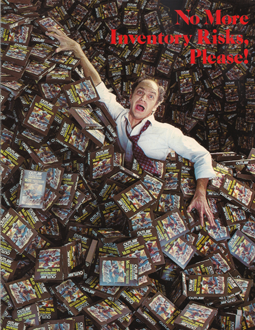 Q: Cumma certainly fits that description, as it was
offering a completely new method for retailing games.
Q: Cumma certainly fits that description, as it was
offering a completely new method for retailing games.
John-Michael Battaglia: Exactly. In an era when unsold inventory was the bane of the video game software industry, Cumma was intended to provide an electronic system of retailing computer software via coin-operated, juke-box-type vending machines located in supermarkets and department stores. Using rewritable cartridges, consumers would be able to download a game, or an application, at a fraction of the cost of buying indelible software cartridges.
As Nolan's publicist, I functioned like a one-man, in-house ad agency which provided a wide range of marketing communications vehicles for Bushnell and his seedling companies: I wrote press releases; produced brochures; took photographs; wrote advertising copy; designed advertisements; obtained publicity; ghost-wrote Nolan's articles; and served as a marketing communications consultant to the various high-tech start-up companies he nurtured.
The Cumma management had decided—at a rather late date in 1983—to participate in the Consumer Electronics Show in Las Vegas in January 1984. So, they came to me for help for creating a presence for them at CES. They wanted to make a splash.
When the Cumma people came to me, they didn't even have a name for their product! With the connotative concept of a transformative, transcendent, really big operation in mind, I borrowed a prefix from the Greek, and I called their software dispensing machine, the "MetaWriter." They loved it.
With the brand name established, I then wrote the copy for the 4-color marketing brochure, which I entitled "No More Inventory Risks." I developed the copy around the theme that software developers, software retailers, and software consumers could rejoice at the arrival of a new technology that promised to revolutionize the video game and computer software industry by eliminating inventory risks and lowering costs across the board.
I hired Roger Ressmeyer, a first-class photographer, to shoot the cover of the brochure, which featured a stressed-out retailer buried amidst a mountain of "Outlaw" Atari video games. To save money, I even played the role of the harried retailer myself.
Q: Where did you ever find so many boxed copies of VCS Outlaw (a 5-year-old game at the time)?
John-Michael Battaglia: I forget exactly where I located those Outlaw boxes, but I've always been pretty resourceful, so, once I hit upon the concept that the best way to illustrate the selling proposition that the Cumma device was designed to eliminate the risks of excess inventory of video games, it became imperative to locate a mountain of game boxes or cartridges to dramatize the
point. I believe that I made a few phone calls to my Atari contacts until I got directed to a warehouse where those old boxes were just gathering dust. I can't recall the specific names and places at the moment, however. As I mentioned, though, when I do get work, I tend to throw myself into it, literally, as well as, in this case, figuratively.
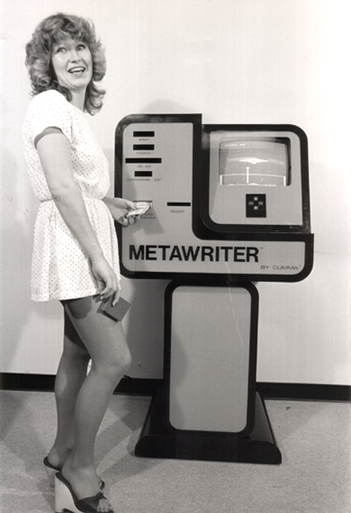
Due to the extreme lack of time, I hired three different artist/illustrators (two of whom were recently let go from Atari!), and I directed them to come up with the imagery for the inside pages of the brochure.
I hired Wendy Szeto, a very good free-lance graphic designer, to layout all the copy and the art work and to prepare the brochure for the printers.
I contracted Balzer/Shopes to do the printing. The deadlines were so tight that Bob Usedom, the printer's representative I worked with, had to put in a rush job. Bob delivered the initial run of brochures to me at the San Jose airport just before I departed for the CES Show in Las Vegas. I brought them along with me as excess baggage. The night before CES opened, Bob also came to Las Vegas with the rest of the order, and I took him out on the town to thank him for all the hard work he made his printers put in to meet our exceptionally-tight deadline.
I created a Press Kit, which consisted of press releases that I wrote and publicity photographs that I took of the MetaWriter in all its jukebox glory.
And, while I was at CES, I hustled around the floor, and I managed to get stories about Cumma placed on the front pages of all the trade show dailies.
On top of all that, I pitched the Cumma story to the TV stations in Las Vegas, and I succeeded in convincing a broadcast journalist to come to the Cumma booth and do a stand-up feature story that was broadcast nationwide via a network-affiliated Las Vegas TV station.
Naturally, I coordinated all public relations functions at the Consumer Electronics Show booth where the prototype product was unveiled to the general public.
Cumma certainly got the splash they asked for: no one could ever doubt that. And it was all done as expeditiously and economically as possible.
Now, after doing all that, can you guess what I got as appreciation?
Q: I can't imagine. A bonus, perhaps? Some stock in the new company?
John-Michael Battaglia: Not quite. At the celebration dinner following our successful participation at CES—a dinner which Nolan naturally attended—Tom Cracraft, the president of Cumma Technology, bribed a waiter to come up beside me and intentionally pour wine all over me.
Initially, I took the incident in stride, viewing it as an unfortunate accident. I actually made light of the incident when it first happened, until my seat mate, Cumma's marketing director, confessed to me that the whole wine-spilling scenario had been pre-meditated and intentionally "set up" to teach me a lesson. Moments after he was sure that his Marketing director had informed me of the intentional nature of the wine-spilling, Cracraft came over to my seat and followed up by threatening me with the idea that I ought to be careful next time I turn the ignition of my car, because it just might explode. He was actually threatening to blow up my car for having included a few lines of credit in small print on the Cumma brochure. As soon as I felt the full force of his insult and his threat, I did not find the wine-spilling incident funny any more, so I immediately left the table.
Q: Why would he do such a thing?
John-Michael Battaglia: Based on my previous interactions with him, I had viewed Cracraft as a rather crude, insensitive person to begin with. So, there was no way that I could experience his pouring wine on me as a baptismal ritual for having done a good job for him and his partners. He was making me an object of ridicule, not a guest of honor.
I was deeply hurt. I should have punched Cracraft's lights out then and there, but I had never struck another human being in my whole life, and I was not going to start then with a scumbag like him.
Cracraft had no honor or dignity. As I subsequently learned after my severance from Catalyst, Cracraft refused to pay the printer, even as much as more than eight months after the brochures were printed and delivered to me. Among other communications, I was carbon-copied a letter from Harold Balzer, the president of Balzer-Shopes, complaining about Cracraft's hostile and argumentative attitude towards him while announcing the commencement of legal action by Balzer-Shopes against Cracraft —both for intentional non-payment and for possible fraud charges. Mr. Shopes concluded his letter thus: "Mr. Cracraft, in nearly 50 years of business, we at Balzer-Shopes have never been subjected to such rude, unprofessional, and immature behavior." So, I was not alone in being the subject of Cracraft’s abusive behavior: this man employed it as a business tactic.
Besides, at that CES celebration dinner party, I realized that Cracraft was merely the messenger. He was functioning as an ass-kisser who was acting on behalf of Nolan and his partner, Al Alcorn, to send me a message. I got the message, all right, and I interpreted it as an insult, so I immediately left the table.
Q: The message being?
John-Michael Battaglia: With so much going on in so little time to meet the CES deadline, a miscommunication had occurred during the copywriting and printing of the brochure regarding the inclusion of credits on the back page of the brochure to everyone who had busted their ass to produce the Cumma brochure. Alcorn contended that he had
sent me a message to strip those credits out; I contended that I never got that message in time.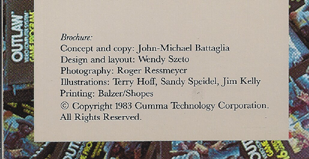
Bottom line, the credits stayed in. They resented the fact that the credits got included in the brochure, so they spilled wine all over me to show their displeasure.
Their petty, rude behavior that night was just another expression of an egocentric belief that they were the only ones who deserved credit in their little world. No one else really qualified; no one else really mattered. It was the same old Atari idea of people at the top not wanting to share the credit with those who actually did the work.
The fact that this particular message was allegedly conveyed to me via Al Alcorn's secretary—someone whose own creditability was completely destroyed when, as I learned much later, she was subsequently found guilty of embezzling from her employer—was information that unfortunately could not be factored in their decision to treat me so rudely. Her deception and her thievery were not unmasked until I was long gone from the scene.
When we all returned to the office, I wrote a long memo to Nolan protesting the way I was treated at that dinner. Since so many had known about the wine-spilling before it had occurred, I had concluded that their behavior was all part of a conspiracy which Nolan must have sanctioned, else it would not have occurred. I got no apology or explanation from Nolan. Instead, Nolan's response was to dispatch Paul Solomon, the guy who originally hired me, to my office to handle the matter once and for all. Dressed up in those cowboy boots he was so fond of wearing, Paul jumped up on my desk, pointed his finger at me, and sadistically yelled at the top of his lungs, "You're fired!"
 Then Paul got down off my desk, composed himself, told me how good it felt to say that to someone, and left. It was so bizarre as to be amusing. When Paul first
hired me, he had actually alerted me to come to expect occasional neurotic behavior from him—I suppose, so that I could forgive it, or ignore it, when it occurred. But that particular demonstration was over-the-top. It was straight out of a bad Hollywood movie. I believe his therapist must have been pleased, though. I got the message, packed up, and left the building.
Then Paul got down off my desk, composed himself, told me how good it felt to say that to someone, and left. It was so bizarre as to be amusing. When Paul first
hired me, he had actually alerted me to come to expect occasional neurotic behavior from him—I suppose, so that I could forgive it, or ignore it, when it occurred. But that particular demonstration was over-the-top. It was straight out of a bad Hollywood movie. I believe his therapist must have been pleased, though. I got the message, packed up, and left the building.
I was at Catalyst Technologies only for a little more than six months, and my direct working relationship with Nolan throughout that time had always been cordial, professional, and respectful. The Cumma incident, however, was an extraordinary revelation. It forced the parting of our ways. I would not tolerate being treated that rudely, and Nolan would not repair the damage that had been done.
Technically speaking, the reason I was terminated was largely related to the fact that Chuck E. Cheese's Pizza Time Theaters, the financial engine for Bushnell's operations, was imploding at that time. When some mismanagement caused stock in that company to plummet, and when investors failed to support Bushnell's other start-ups in a timely fashion, Nolan decided to eliminate the public relations department and others as part of a cost-cutting strategy. Along with the financial upheaval triggered by Chuck E. Cheese's collapse—it went bankrupt by the end of that year—the emotional baggage that was associated with the Cumma incident made terminating me that much easier for Nolan.
Q: How many MetaWriter machines were actually produced and put out on locations?
John-Michael Battaglia: As far as I know, absolutely none. By mid-1984, their business plan had called for getting several hundred MetaWriters out to cooperative retail stores on a pilot test basis, ostensibly, in order to get some statistics that they could plug into a business plan to reap some profits in a next round of financing. But I was long gone by then, so I can't say for sure if they managed to place any MetaWriters on location during their pilot roll-out stage, or not.
No matter. Their ultimate fate was sealed.
Cumma's idea for the electronic distribution of software did not catch on. To the best of my knowledge, Nolan, Al, and Tom were unable to attract the necessary significant capital to go into mass production. So, their enterprise died a natural death in the marketplace.
They wanted it all to be their show: let them take the credit for its failure.
Q: Besides Atari, did you work for any other game companies?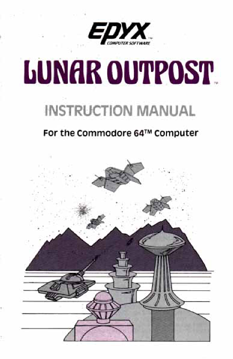
John-Michael Battaglia: Yes, I did. The day after I left Catalyst Technologies, on a free-lance basis, I got a job writing the instruction manual for the Commodore 64 version of Lunar Outpost, which was produced and distributed by Epyx. About a year later, also on a free-lance basis, I wrote the instruction manual for the Commodore 64 and Apple II computers’ version of Karate Champ, the classic arcade game manufactured by Data East. Berkeley Softworks did the computer programming.
In between that time, which was most of 1984, I worked on staff for The Software Machine as their Director of Corporate Communications. During that same period, I also did some consulting work on proposals and game design prototypes in collaboration with Rob Fulop, a former game designer at Atari.
Also, after I left Silicon Valley in 1987 for Los Angeles, where I wanted to concentrate more on pursuing a career in scriptwriting and filmmaking, I worked on staff as a Producer/Project Manager for a young start-up company called The Dreamer's Guild, and I did some free-lance scriptwriting work for Philips Interactive Media of America.
While in Los Angeles, I also worked as a writer with Bob Abel at his Synapse Technologies on his innovative, interactive, multi-media educational project called Columbus: Discovery and Beyond. Strictly speaking, that was not a video game company per se, but the skills called for to participate on that project were quite similar to those demanded of any programmers, interface designers, writers, graphic designers, artists, and video producers working in the production studio of any game company of the early nineties.
Q: Can you tell us about The Software Machine?
John-Michael Battaglia: Argh! Unfortunately, there's another heart-breaking story. It started out great, with lots of hope and expectation, but it ended badly—not just for me, but for everyone concerned.
The Software Machine was an undercapitalized, software start-up company formed by a small group of ex-Atari employees after Atari collapsed. We all recognized that the "shoot 'em up" games had fallen out of favor, but we thought there might be a market for computer software products which made learning fun, so we pooled our talents together, and, in the then-burgeoning tradition of Silicon Valley entrepreneurs, we went for the gold.
The Software Machine had moved into the Catalyst Technologies building while I was working there. They were not one of the companies that Nolan was nurturing. They were renting space there to give the illusion to the outside world—which, when translated, meant venture capitalists—that they were supported by Nolan and shielded under the Catalyst umbrella.
Q: Who were these ex-Atari people?
John-Michael Battaglia: Condon Brown, who was the former Director of Software Development at Atari, was the president of The Software Machine. I liked him a lot. He was a very charming man. He was also a gifted man who knew the value of image and illusion.
Before the big dispersal of talent that followed Atari's collapse, Condon gathered together a few game designers and others, and he convinced them to join him in forming The Software Machine to concentrate their talents on creating educational software. This included game designers W. Sean Hennessey, Michael Sierchio, and Gary Shannon; audio engineer Andy Fuchs; graphic artist Marilyn Theurer; William Lord as Director of Sales and Business Development; and myself, as Director of Corporate Communications.
Q: How did you get involved with them? What happened?
John-Michael Battaglia: I had met Condon during the time we both worked at Atari, I think during one of my visits to consult with a game designer, or during one of his visits to the Consumer Graphics Department. It must have been after my work on the EarthWorld contest was published, because he had heard of me by then.
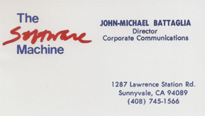 I remember telling him then that I was interested in becoming a game designer, but that I had no programming expertise. He told me flat out that it wasn't the ability to
write code that made someone a game designer: it was their creativity and imagination and ability to structure game play within the confines of the medium. He said I already had those qualifications, so he told me not to bother wasting time teaching myself to be a programmer. He told me that he would team me up with game designers and that we could collaborate on coming up with entertaining software products.
I remember telling him then that I was interested in becoming a game designer, but that I had no programming expertise. He told me flat out that it wasn't the ability to
write code that made someone a game designer: it was their creativity and imagination and ability to structure game play within the confines of the medium. He said I already had those qualifications, so he told me not to bother wasting time teaching myself to be a programmer. He told me that he would team me up with game designers and that we could collaborate on coming up with entertaining software products.
So, when Condon learned that I was no longer attached to Catalyst Technologies, he approached me with a rough draft of the business plan for The Software Machine, and he asked me to consider joining him and the others in their brand new venture. My main function would be to handle all marketing and corporate communications, but I would also get to work on developing our educational software games by conceptualizing and writing the project proposals, as well as working closely with the game designers as they were writing the code to implement our projects.
Q: Sounds great. What happened?
John-Michael Battaglia: Yes, it did sound great. Condon had painted a picture for me of my perfect job. I would be doing what I liked to do; I would be making good money; and I would be getting stock in a start-up company, that, if it all worked out, would allow me to make the money to buy the time to write some spec screenplays and make some movies.
Condon sold me on an illusion, and I bought it—hook, line, and sinker. That was the essential problem: it was all an illusion. There was never any money, so I never got paid. Not a single dime in the more than six months that I worked for Condon Brown, and his Software Machine. Besides not getting paid for writing the business plan and several project proposals, Condon never even reimbursed me for the expenses I incurred in doing my job. I know that, towards then end, he was slipping a little bit of money now and then to those who squeaked the loudest about their impending impoverishment, but I got nothing from him.
Q: How could such a thing happen?
John-Michael Battaglia: Very slowly. Very subtly. Very seductively.
With Condon, from the very beginning, we were always only "two weeks away" from getting our venture capital funding. Everyone was essentially funding himself, working "on-the-come," believing and trusting in Condon that the deals he was lining-up with the venture capitalists were actually taking place and that, as he claimed, it was always the lawyers who were to blame for dragging things out.
We all bought into it, because we were all dreamers, and we wanted to believe in the dream. Condon was a master at manipulating us to work for just "two more weeks," by which time the money was sure to arrive. But, the money never did come.
The situation was untenable. By mid-July of 1984 Michael Sierchio had left. Condon claimed Michael was not producing, but Michael felt poorly treated by Condon, and he did not want to hand over any products until the financial mess and the stock allocation situation was all cleared up. Condon was loathe to put things like stock allocations down in writing, so he would often verbally switch stock allocation percentages around—like a carrot on a stick—to induce people to stick around longer.
Then he attempted to designate all of us as independent contractors, instead of as employees, in order to circumvent some labor and tax laws.
Eventually, painfully, each of us woke up to reality - economic reality! We had bills to pay, mouths to feed, and we couldn't go on without income.
As I now read over my journal notes for mid-July 1984, I had concluded then that: "Something is not right. Condon is a hustler, and he has succeeded in hustling us to do his work, without giving anything away." Obviously, I felt conned, and I had to extricate myself before things got even worse.
If I recall correctly, at least two team members had to declare personal bankruptcy. I, too, probably would have qualified in declaring bankruptcy, but my pride wouldn't let me do so. I made myself tough it out somehow.
Over the next couple of years, Condon refused to pay me my back wages or to reimburse me for the out of pocket expenses I had incurred while working for him. It all came to about $25,000, a significant amount for me, so I sued Condon Brown in the Superior Court of the State of California at San Jose. Since Condon had not been operating The Software Machine in compliance with the rules for running a corporation, it was legally possible to pierce the corporate veil and hold him personally responsible. In mid-1986, I won a judgment against him, issued by the Division of Labor Standards Enforcement of the California Labor Commissioner.
Sean Hennessey also sued Condon for back pay and expenses, and he also prevailed in his claim against Condon. I was a witness at Sean's hearing; he was a witness at mine. At the hearings, the judge informed Condon that it was illegal in the United States to employ people without paying them wages.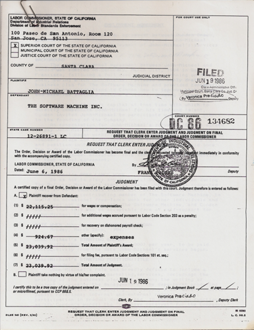
Although I won my case against Condon, I was never able to collect. I don't think Sean got anything either. My only resort was to claim the whole amount as a loss on my income taxes.
Although it was a financial disaster, I learned a lot from that experience. First and foremost, I will never again do any work for anyone on any project on a speculative or "on-the-come" basis, no matter how attractive a picture they might paint for me.
Secondly, I also had to realize that, while there are sharks out there whose nature it is to try to take advantage of easy-going guys like me, it is still my responsibility not to be complicit with them. I must be on guard against projecting my nice guy qualities onto them, simply because I may like the picture they paint for me.
I worked closely with Condon, so I did not get to know the other members of The Software Machine, except for Sean. He was one of sweetest, gentlest, most soft-spoken guys I had ever met. He liked to joke: "Last year I couldn't even spell engineer. Now I are one." Our nice guy personas must have been easy meat for someone like Condon to manipulate as well as he did for as long as he did.
At the same time that I report about this unfortunate incident, I did not then, and I do not now, believe that Condon was a bad person, or that he intentionally tried to deceive us or cheat us. Maybe saying that now after so many years have passed is still an expression of my nice guy persona. I can't tell. I think that he was just probably doing the best he could to get a new business going using the knowledge and skills he had at the time. It was precisely that cognitive dissonance between how I wanted to see Condon and our enterprise, in contrast to the way that he was behaving and how things were unfolding in reality, that caused all the anxiety, stress, and chaos which we all experienced.
Poor Sean: his hair turned prematurely white during that troubled, stressful time.
Q: What about the other companies you mentioned?
John-Michael Battaglia: After The Software Machine debacle, I re-oriented myself in the direction of script-writing and film production. I kept looking for staff jobs, but I couldn't find any place to land. That's always been my problem, I guess. Nonetheless, over the next couple of years, I did manage to get some free-lance jobs as a writer-producer-director of corporate-industrial videos for several high-tech companies in Silicon Valley, specifically Hewlett-Packard, Xerox, Amdahl, ITT, Chevron, and Triad Systems.
But those projects were either training or marketing videos for the corporate-industrial sector: I yearned to work in the world of entertainment. So, when my landlady wanted to recover use of my tiny Los Altos garage apartment after her husband's death, I left Silicon Valley in 1987, and I moved to Los Angeles to concentrate more on pursuing my original career goals: scriptwriting and film production. To support myself while I wrote spec scripts that I hoped would gain me entry into the tightly guarded Hollywood citadel, I took any work I could get that called upon my writing skills, my creativity, and my over-arching interest in media of all kinds. Naturally, that included working on interactive, multi-media games.
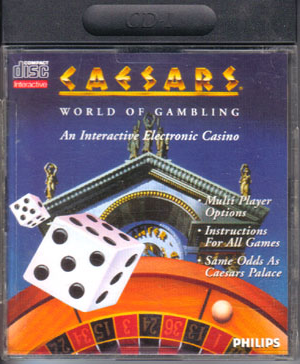 One of those calls came from Philips Interactive Media of America in 1990. Formerly called American Interactive Media (AIM), Philips Interactive Media of America was a
publishing company involved in the design, production, and distribution of educational and entertaining programs on interactive compact discs, using a new technology referred to as "CD-I," which stood for Compact Disc Interactive. They called their Philips CD-I player "The Imagination Machine."
One of those calls came from Philips Interactive Media of America in 1990. Formerly called American Interactive Media (AIM), Philips Interactive Media of America was a
publishing company involved in the design, production, and distribution of educational and entertaining programs on interactive compact discs, using a new technology referred to as "CD-I," which stood for Compact Disc Interactive. They called their Philips CD-I player "The Imagination Machine."
At an advanced stage in the design cycle of Caesar's World of Gambling, Dave McElhattan, the vice president of production at Philips, hired me to write the tutorials that would teach users how to play the craps, roulette, blackjack, and slot machine games that were already programmed on the disc. My task was to write narration and to design tutorials that would blend with their existing data base of images. I also wrote the general introduction and the on-line help section under the same design constraints.
This was one of those projects in which Phil Mittleman, the producer and project manager, had not only secured the funding from Philips to develop the ideas he had submitted in his proposal, but that he had also assigned himself to write all the content. However, several months and many script drafts later, upper management grew unhappy with the way the content was being presented.
Essentially, I was brought in over Phil's head to function as a script doctor to fix his baby. It was a very delicate situation. I reported directly to Dave, the vice president of production, not to Phil, the producer. At first, Phil resented my presence and treated me coldly. But, as I got down to work and staring turning out drafts, he warmed up and became more co-operative. By the time I was done, all parties agreed—especially Phil himself—that my scripts rescued a project that was about to be aborted.
My understanding was that the Caesar's World of Gambling discs were not only marketed as CD-I titles, but that they were also used at Caesar's Palace in Las Vegas to teach gamblers how to play those games. I may love playing games, but I don't frequent gambling casinos, so I never really had a chance to check that out.
Hell, I didn't even know how to play craps or roulette when I took on the assignment! I had to teach myself at the same time that I taught others—all within the confines of the game as it had already been coded into the CD-I when I took on the job.
Q: It sounds similar to what you did with the Atari SwordQuest play-off contest for EarthWorld
John-Michael Battaglia: Yeah, I guess it is. In the sense that, in both cases, I was given a completed—or nearly completed—program that had serious problems which needing fixing without spending additional money or time re-coding the program, yes, I suppose it was deja vu all over again. Except that the EarthWorld fix took me only two days, while my records show that it took me 290 hours over five weeks to write those gambling tutorial games and their on-line HELP system from scratch.
Q: Do you really keep such records?
John-Michael Battaglia: Sure. I'm a pack rat. I probably have copies of practically everything I've worked on and everything I own, all stored in folders or boxes that are numerically and topically indexed in a relational database I created in FileMaker Pro, a great database program that was originally developed on the Mac, but was later ported to Windows, too.
I may let the dishes pile up in the sink for quite a few days, but I live alone, so I can tolerate the mess before I get to doing them. At core, though, I'm a pretty well-organized person. A writer has to be, in order to pull disparate information together and structure it in all in a meaningful way. It's a discipline.
I couldn't manage to track all this kind of information, though, without FileMaker Pro. It contains my MasterFileIndex, which I use to indicate what things are located where, as well all the subsidiary databases I've developed over the years to track items like my computer software inventory and licenses, my web site passwords, my audio CD collection, my DVD collection, my software disc backups, my job history, my portfolio of work samples, and a variety of other stuff.
Q: What of The Dreamers Guild?
John-Michael Battaglia: They were trying to develop software for the Sega CD market. I worked primarily on the conversion of the Revell-Monogram's European Racers game on the IBM PC to a SEGA CD-ROM format. Unfortunately, unlike Atari, this was an extremely stressful and unproductive work environment.
I was assigned to supervise a project from hell at an under-capitalized startup which had difficulty meeting its payroll obligations as well as its product deliverables on the agreed-upon schedule, which was wildly unrealistic from the git-go. I had disagreements with the youthful, considerably inexperienced, upper managers on how to re-allocate the workload among our resources and how to interact with clients to achieve a healthier outcome for all.
They considered me "insubordinate" for suggesting different ways to restructure their key roles. I didn't want to abandon them, but the job they gave me was impossible to perform within the given parameters, so we parted company after only two months. Within three months of my departure, the company failed to meet payroll and collapsed.
Also, while I was still in the Los Angeles area and my head was still somewhat interested into developing software products, I wrote a couple of game proposals, but I couldn't generate any financial interest to get them off the ground.
Q: What project proposals were those?
John-Michael Battaglia: Well, being an avid bowler who knows quite a lot about the technology of the game, in the early nineties, I wrote up a proposal for a bowling game that not only could be played on its simplest level, but which also incorporated a lot of multi-media features and extras to make the game more challenging as well as more informative. In my mind, the key piece of the puzzle that needed to be developed to make the whole thing coalesce was a new type of interface device.
I wasn't thinking merely in terms of an Atari joystick, or a rotating ball and a trigger button in combination. I was envisioning—and lusting for—some kind of interface that mimicked the hand and wrist movement of real bowling during the arm swing and the release. That's how you apply the hook, or curve, required to generate the correct angle of entry into the pocket that results into strikes. When you blend that interface technology with the application of different oil patterns on the lane, as my proposal called for, you get a game that is not only several steps closer to the reality of the actual sport of bowling, but which is also easy and fun to play, but hard to master.
Q: It sounds like you were imagining an interface device like Nintendo’s Wii.
John-Michael Battaglia: Yes, I suppose it does. Too bad I didn't know about Wii's development at that time, or later. When I submitted my proposal to Philips Interactive Media for consideration, someone turned it down, saying that she didn't even know that oil was put on a bowling lane.
Q: What was the other proposal?
John-Michael Battaglia: I called it Word Power. Upon reflection, I wouldn't call it a game, per se. It would have to be designed and presented within the context of entertainment, of course, but its main thrust was educational.
Word Power was a proposal for an entire series of multimedia software products designed to help people throughout the world improve their vocabulary. We would produce the first set in English, of course, and, drawing upon the data base of still images, movies, illustrations, graphics, and sounds we would have created, we would translate the English version into other languages, adjusting for localization and national customization, as we progressed.
As I envisioned the product, it would have required a small production studio of artists, graphic designers, writers, filmmakers, and computer programmers to pull it off. In my product research phase, I had, of course, seen snippets of the elements of vocabulary building products strewn about over the years, but none, to my way of thinking, really incorporated all of the elements in the kind of interactive, multimedia series that I was thinking about.
With the advent of the Internet, some pieces of that product may have started to come together, and, maybe for most people, that's adequate. But I still haven't seen the full implementation, nor experienced the impact that doing the job right would have. Maybe someone has done it since then. I don't really know. After a while, when you get turned down with the best you have to offer, you tend to stop proposing things. At least, that's what happened to me anyway.
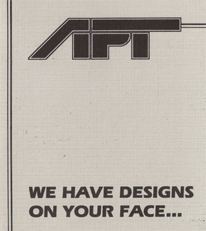 Q: You mentioned working with Rob Fulop on some projects outside of
Atari. Was this for Imagic, or PF. Magic?
Q: You mentioned working with Rob Fulop on some projects outside of
Atari. Was this for Imagic, or PF. Magic?
John-Michael Battaglia: Neither. Rob Fulop and I connected in 1984 as a couple of free-lance, independent contractors who pooled our talents to see what kind of business we could drum up. Since The Software Machine wasn't paying me, I needed to take on some free-lance work just to survive. As Billboard magazine's "Game Designer of the Year" in 1983, an honor which was based on the fact that his games for Atari and Imagic had generated over $50,000,000 in sales, Rob was still quite a hot commodity, but he was now out on his own.
In association with his partner and fellow game designer, Dennis Koble, Rob was operating then under the business name of Advanced Program Technology, "a full-service software production specializing in designing innovative, interactive user interfaces for companies involved in the delivery of information through computerized data bases." I ought to know, because I wrote the brochure introducing his new business venture to potential clients. It was entitled: "We have Designs on your face..." When you turned the page, the copy began to promote APT's skills and experience in creating easy-to-use, interesting, and entertainment designs of your interface.
During the eight months that we brainstormed and collaborated, I wrote up the outlines and proposals for a few of the projects Rob had in mind when he first came to me, as well as the projects that evolved during our interaction.
Q: What projects were those?
John-Michael Battaglia: One of the project proposals I wrote up was what Rob called The Alice in Wonderland Software Series. Under his APT umbrella, Rob wanted to raise money to support the development of a brand name of software products that would blend educational content into the format of entertaining, interactive computer games which drew upon the adventures of Lewis Carroll's Alice in Wonderland. Rob had lined up Graham Rankin, a nationally-recognized educator with extensive teaching experience in the use of computers in educations, as his substantive authority in the field of education. The overall goal was to create a whole line of entertaining, educational products intended to teach children between the ages of 4-10 the skills involved in the process of thinking. The entire venture was based on the developmental work of Jean Piaget, an eminent child psychologist whose pioneering work had mapped out the logical processes that the mind goes through in its intellectual development.
Having written the script for an unproduced radio drama of Alice in Wonderland while I was a grad student in Film/TV/Radio at Syracuse University, I was quite familiar with Lewis Carroll's work, so I thought Rob's idea was quite fertile. Once you go through the looking glass into another dimension, there is no limit on you, other than your imagination and the current state of technology. I was eager to get involved on the ground floor of this new enterprise, but we were unable to generate the necessary financial support to make it all happen.
Another project we collaborated on had to do with the development of "Sky Trays" for the airline industry. We were trying to get into the business of transforming the standard, food-carrying tray into flat panel displays containing a variety of software, starting with games and information and extending through the entire range of interactive software vehicles that would make air travel pass more pleasantly for all.
Rob had made a connection with a firm called Interactive Communications Corporation (ICC), which was a start-up company within Altus Corporation, a computer manufacturer. ICC wanted to replace the ordinary food trays used on commercial airlines with a product of their own design—a computerized food tray that would have a flat display screen and a chip that would be programmed with "soft" advertising messages. ICC intended to sell space on these "Sky Trays," much like other media sell time and space on their advertising vehicles.
While ICC had a group of hardware engineers developing the technical aspects of the product, I teamed up with Rob to come up with some pilot programs that would appeal to both advertisers and to the traveling public. After several brainstorming sessions, Rob and I came up with Time for Trivia, an updatable news-and-history game (intended to be sponsored by TIME magazine), and Investment Strategies, a money management game (intended to be sponsored by a large brokerage firm).
I wrote the story-lines and interactive copy; Rob programmed the computer code.
Q: What ever happened to those "Sky Trays"?
John-Michael Battaglia: As far as I know, they're still grounded in the hangar of great project ideas that never got the venture capital funding to lift-off. Rob and I satisfied our end of the bargain: we delivered the software prototypes that proved the concepts we had proposed.
But the hardware didn't come together as hoped. After further thought, Altus decided not to invest in developing this project further. So, the project was aborted; funds were re-allocated to other projects.
The Altus executive we worked with, Paula George, parlayed the ground-breaking concept of software-plus-advertising into a marketing communications business. She left Altus and formed her own company, calling it "SoftAd."
I really like collaborating with Rob; I thought we clicked pretty well. But, having failed to raise money for our projects, Rob and I went our separate ways.
Q: You also worked at Activision, writing a user’s guide for an Atari 8-bit word processing program. Do you recall what the name of the program was? Was that the only Activision title you worked on?
John-Michael Battaglia: My online resume contains a mixture of staff jobs as well as free-lance assignments. You are mistaken in interpreting that I worked at Activision.
I never worked at Activision. I did bug them on several occasions over a period of time to see if I could get a staff job at Activision so that I could hopefully continue to work in a creative way in the development of games or other educational and entertainment software products—either as a writer, or as a producer, or as an associate game designer in-training. But the only bone Activision ever threw my way was a free-lance assignment to write an instruction manual for a word processing program for the Atari ST computer called Writer's Choice Elite.
I remember that assignment as a short-term project that got aborted way before I could make any impact on the program or on Activision. My notes in the file folder related to that project inform me that the product was cancelled by the marketing department at Activision late in the development cycle. I got paid, of course, but I stopped looking to Activision for work after that waste of my time.
Q: Your resume is, quite simply, impressive. You’ve done extensive work in other areas, beyond creative and technical writing. Of all the different work experiences and companies you’ve worked for, which have been both the most and least enjoyable?
John-Michael Battaglia: Thanks, Scott, you're very kind to say that. It's nice to be appreciated. You don't by chance happen to have any work that I could do to make money? I might have an impressive resume and a lot of skills, but I haven't had any income-generating work in nearly two years, so I really need a job right now. That's my top priority!
Throughout my career, I have learned that, whether one has an enjoyable work experience at any particular company in any given industry is not so much based on the nature of the job one does there, nor even on the nature of the industry, but on the quality of the interaction one has with the people who are also associated with that particular business enterprise.
For example, I think that I made it pretty clear that my employment with Catalyst Technologies' Cumma Technology and with The Software Machine were among the two worst job experiences of my entire career. In both cases, I liked the work I was assigned to do, and I performed my duties well. But the way I was treated by the management of those business entities, and the way we parted company, was so rude and so horrific that, on balance, my overall experience of working with those people is skewed heavily toward the negative end of the scale.
Fortunately, throughout my career, I have many more positive, enjoyable experiences than negative, unpleasant ones. I am a creative type of person, and I take pride in my versatile communications skills. So, when I seek work, I consciously look for healthy challenges to my creative spirit. Writing is my strength and my primary skill, so I generally seek out opportunities which challenge me to master some new subject and make some kind of report in whatever medium is most appropriate, from written articles and business plans, to project proposals, game designs, video scripts and film screenplays.
While I mostly enjoy the creative process of working in some form of communications media, or on some type of communications challenge, I have also learned that there many kinds of jobs which can be just as challenging and just as creative.
Take, for instance, the Peace Corps. Serving as a Peace Corps Volunteer, which was my very first job upon graduating from Colgate University, was an incredibly creative, challenging, and enriching experience. Learning a foreign language so that one is fluent in it, then spending four years in a foreign country working on a mission to help that country develop itself was an intrinsically rewarding experience whose benefits I have reaped throughout my whole life. It was a never financially rewarding time, for Peace Corps Volunteers live on subsistence allowances. But that did not matter. In addition to the inestimable value of learning three different cultures—the Malay, the Chinese, and the Indian—I also learned early on that, for true ego satisfaction, it is not really how much money you earn that counts, but how you earn your money. This does not denigrate the intrinsic value of money; it elevates the social value of work and service to others.
I think that I also made it clear that I considered working as a Senior Copywriter at Atari to be one of the most enjoyable experiences in my entire career. I'd also have to say that working at Atari was a milestone in my life, and that, for me, Atari really was a special place.
Before I worked at Atari, I was exclusively focused on carving out a career in the film business as a scriptwriter and producer-director. By going to work at Atari, I got exposed to computers. I learned about video games and software design. I learned about digital multimedia. I learned how to use word processing software, and spreadsheet software, and database software. I learned to use a Wang computer terminal at the office, so I bought Wang PC's to use at home. I then bought Macintosh computers. And PowerTowerPro Mac clones. Now I have a home office with several Macs running OS X and legacy PowerTowerPro clones running OS 9, all networked together.
Oh-my-gosh! What's happened to me? I've turned into a nerd. I've become a software junkie!
Maybe it's time to get back to writing another spec screenplay. If no one will give me a job, I may have to do that just to keep from going insane. If I have to work "on-the-come" again, I'll do it for myself, no one else.
Q: Being that you have some background in film production (a Master of Science in TV/Radio/Film, and a Master of Fine Arts in Cinema/Drama), once managed a cinema theater, and even had a brief stint at Skywalker Ranch, I wanted to get your opinions on the film industry as it exists today – whether it’s the push towards digital and 3-D films, what directors and writers you feel are at the forefront, some of the problems it faces, etc.
John-Michael Battaglia: That is such a huge question that no one can possibly answer it with any degree of authority or certainty.
As William Goldman, one of the great scriptwriters, wrote in his book, Adventures in the Screen Trade, the single most important fact around which the entire film industry rotates, is this: "Nobody Knows Anything." By that, he means that "Not one person in the entire motion picture field knows for a certainty what's going to work. Every time out, it's a guess, and (if you're lucky) an educated one."
This was true back in 1983 when he wrote it; it was true in August 1984 in Los Altos, California when I read it; and it's still true now.
With that in mind, I happened to see James Cameron's Avatar the other day, and I have to admit that it blew me away. Avatar will be recognized as a high-tech, special effects breakthrough in the history of cinema. No question about that. Cameron is a masterful filmmaker burning with an intense desire to push technology beyond its limits to tell us stories with visual effects that are magical and awe-inspiring. We should all be grateful that such a person exists to provide us with this extraordinary form of cinema by buying a ticket and seeing the movie at least twice.
At the same time, however, the world of cinema is a vast, artistic vehicle in which we can tell all kinds of stories. Not every story will need a budget of $200,000,000 to produce, or a crew of 2,000 technicians to work on it, like Avatar did. It's expensive enough as it is to make a movie and distribute it. The entire film industry as we know it would collapse if it tried to turn out 3-D special effects blockbusters all the time.
No doubt that there will be imitators trying to jump on the bandwagon that follows in the wake of Avatar's success. Copycats abound! That's always been the way in Hollywood. But, as William Goldman astutely points out: there is no guarantee of success. Even if you have a good story first and foremost, and even if you have all the elements of the production serving to tell that story—from actors' performances through special effects—you still never know how your movie will be received in the marketplace.
Even as a teenager, I recognized the cinema to be the most powerful art form ever developed by the mind of man. That's why I wanted to work in it; that's why I still want to work in it. Problem is, movie-making is the riskiest business in the world. Let no one fool you about that.
The people who put up the money to make movies do it only to make more money. The bigger the budgets, the greater the tendency to cut down on the risks. Cut down on the risks, and you eliminate a lot of stories that need to be told. We'd end up with recycled corporate pabulum and platitudes that serve the existing power structure and cultural ethos. Goodbye, independent thinkers. Hello, Brave New World.
Not for me, thanks. Give me variety. Make way for both the Avatar blockbusters, as well as the independent films made with love by a crew of ten for less than $100,000. Depending on the quality of the story, I can cry at either one. I won't need ten-foot tall blue people living on a distant planet 4.5 light years away to relate to their emotions.
Q: Which of your titles are your favorite, and what types of games in general do you like?
John-Michael Battaglia: I guess Atari 5200 Football and Space Dungeon are my favorites, for the reasons I specified when I talked about them earlier in depth.
I like many types of games, but over the years, I made sure that, just because I once worked at Atari, I did not get addicted to playing a lot of computer games.
I don't own a game console. I do play a few games on the Mac platform. I occasionally play Chess, or Risk, or Scrabble, or Shanghai, or You Don't Know Jack.
In lieu of a real train set, I usually pull out Railroad Tycoon at Christmas time and have over a dozen trains hauling cargo and passengers from Buffalo to Boston, and all points in-between. There is so much going on in Sid Meier's game that it boggles my poor mind.
Q: Have you stayed in touch with any of your former co-workers?
John-Michael Battaglia: Unfortunately, no. I completely lost contact with the other writers and artists in the Consumer Graphics Department at Atari. Former game designer Sean Hennessey and I remained in contact by mail and phone for a few years after working together at The Software Machine. I think I visited him in San Diego once, then we lost contact. I don't know where he might be or what he's been up to since then.
I don't really like feeling so isolated, but I guess I've never been the kind of person to keep up relationships if the original impetus for the relationship had long passed. Perhaps that's my fault. Perhaps it's just the way things go.
It would be wonderful to re-connect with old friends, and colleagues. If people from my past saw this interview and dropped back into my life, I’d welcome it. But I tend to be the kind of person who’s hesitant to intrude on people's lives for no reason at all.
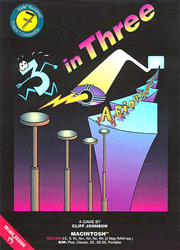
Q: What are your thoughts on how the industry has evolved?
John-Michael Battaglia: Since my career was neither primarily nor exclusively within the game industry, I am not really qualified to comment on how such a vast enterprise has evolved. It would be similar to trying to comment on the film industry, or the book business. I wouldn't be able to get my arms around such topics to discuss them intelligently. I doubt that anyone could.
So many games have come and gone that I never played, nor ever noticed.
Hell, gimme a break, Scott! I'm still trying to work my way through the great puzzle game, 3 in Three, a MacWorld Hall of Fame game designed by Cliff Johnson back in 1990.
I really had no idea that there was such a world-wide interest in those old Atari video games that I loved to play—as well as to promote—though my instructional game manuals and my advertising copy on the box.
I had created the video game pages of my portfolio web site for no other reason but to display additional examples of my versatile copywriting skills. It has been through the regular visitations to my web site by people interested in the story of the SwordQuest playoff contest that I only recently became acquainted with the legions of people dedicated to keeping those old games alive. I think all of this is fantastic: it's like a worldwide club of people sharing a common passion.
Isn't the Internet great?
Sadly, John passed away in 2016. My condolences to his family.